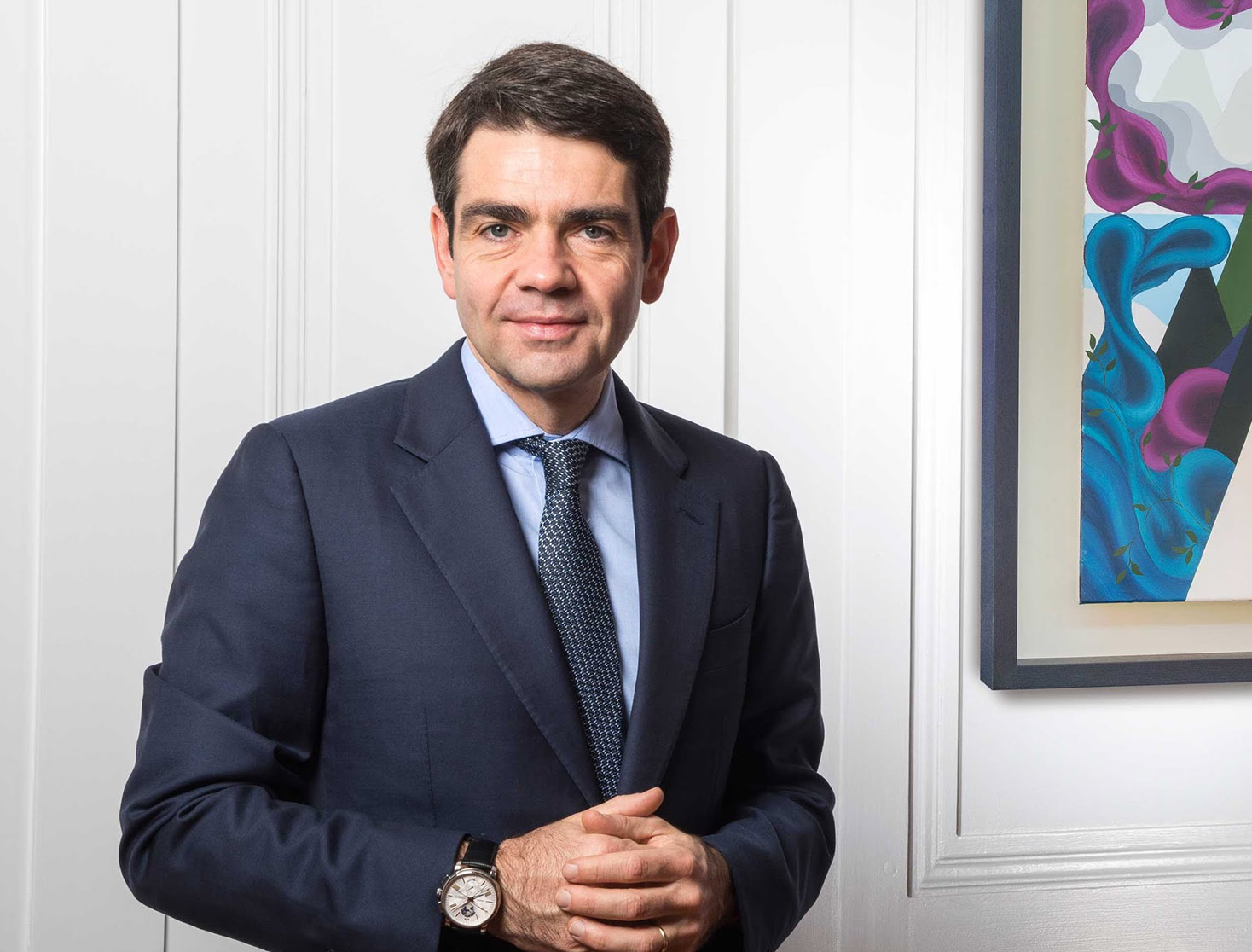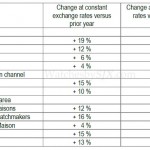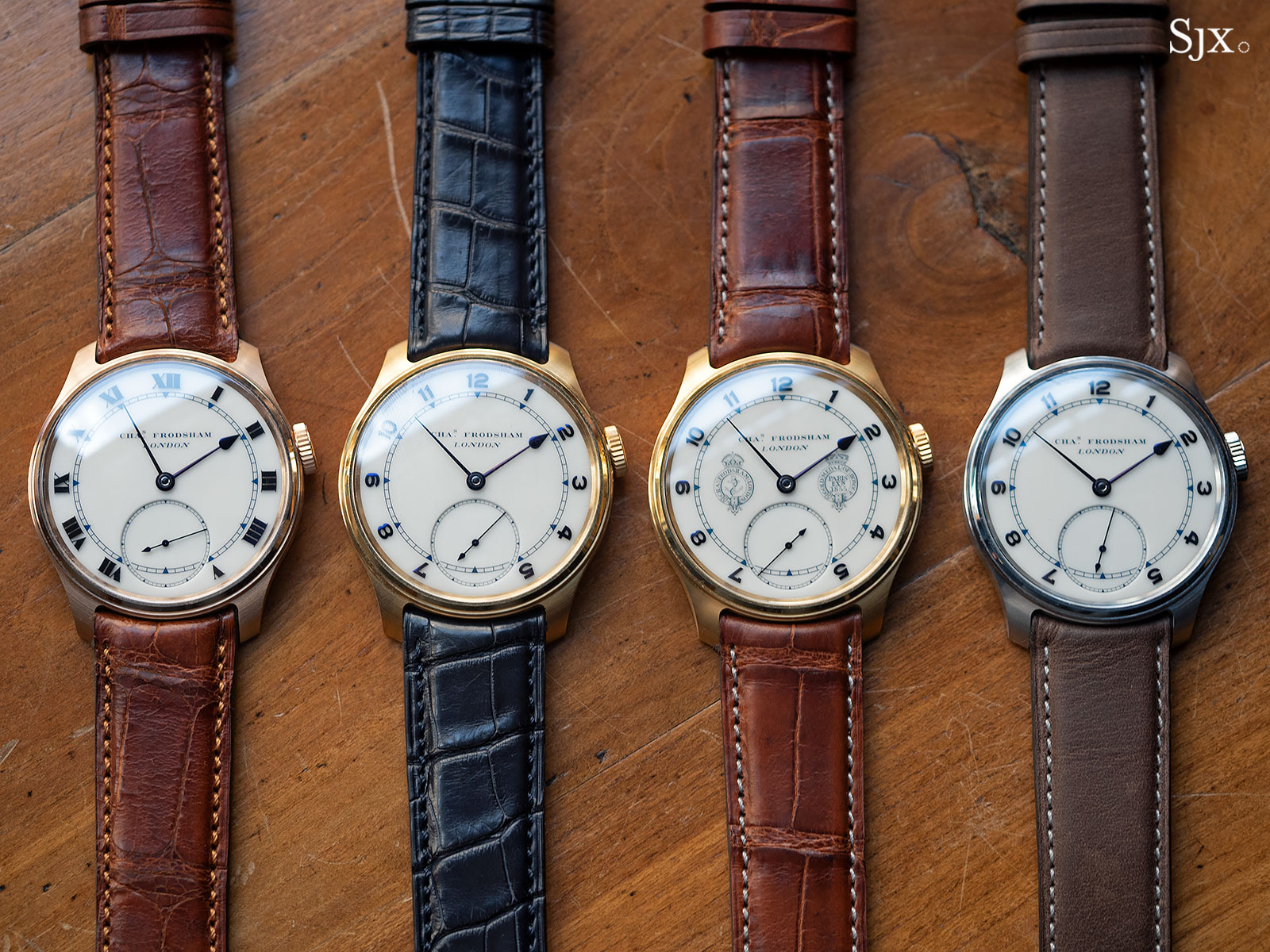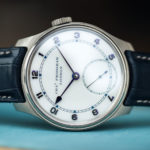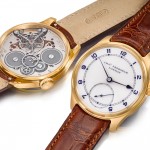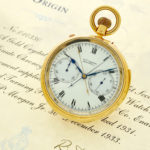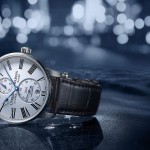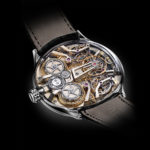The list of modern day, high-end English watchmakers is a short one. George Daniels and his contemporary Derek Pratt will be high up on the list, but both have sadly passed on, though Mr Daniel’s protege Roger W. Smith still continues his good work. Peter Speake-Marin and Stephen Forsey are English, though both practice their craft in Switzerland.
Now firmly on the list is Charles Frodsham, which recently unveiled its Double Impulse Chronometer wristwatch. Despite only recently becoming prominent as a maker of wristwatches, Charles Frodsham is ironically a grand old name in English watchmaking. Mr Frodsham founded his business in 1834, three years before Queen Victoria ascended the British throne.
Today Charles Frodsham has been continuously operating for 184 years, albeit under different owners but nevertheless a remarkable achievement given that the rest of the once great English watch industry has evaporated. Owned by Philip Whyte and Richard Stenning since 1997 – with a fourth generation descendent of Charles Frodsham on the board – the company is located in upscale St James’s in London, though its workshop is just outside London.
The firm does most of its business today restoring antique Frodsham clocks and pocket watches. But the firm also spent the last 16 years working on the Double Impulse Chronometer. Despite the lengthy name, the watch is deceptively simple on its surface, modest in a thoroughly English manner.
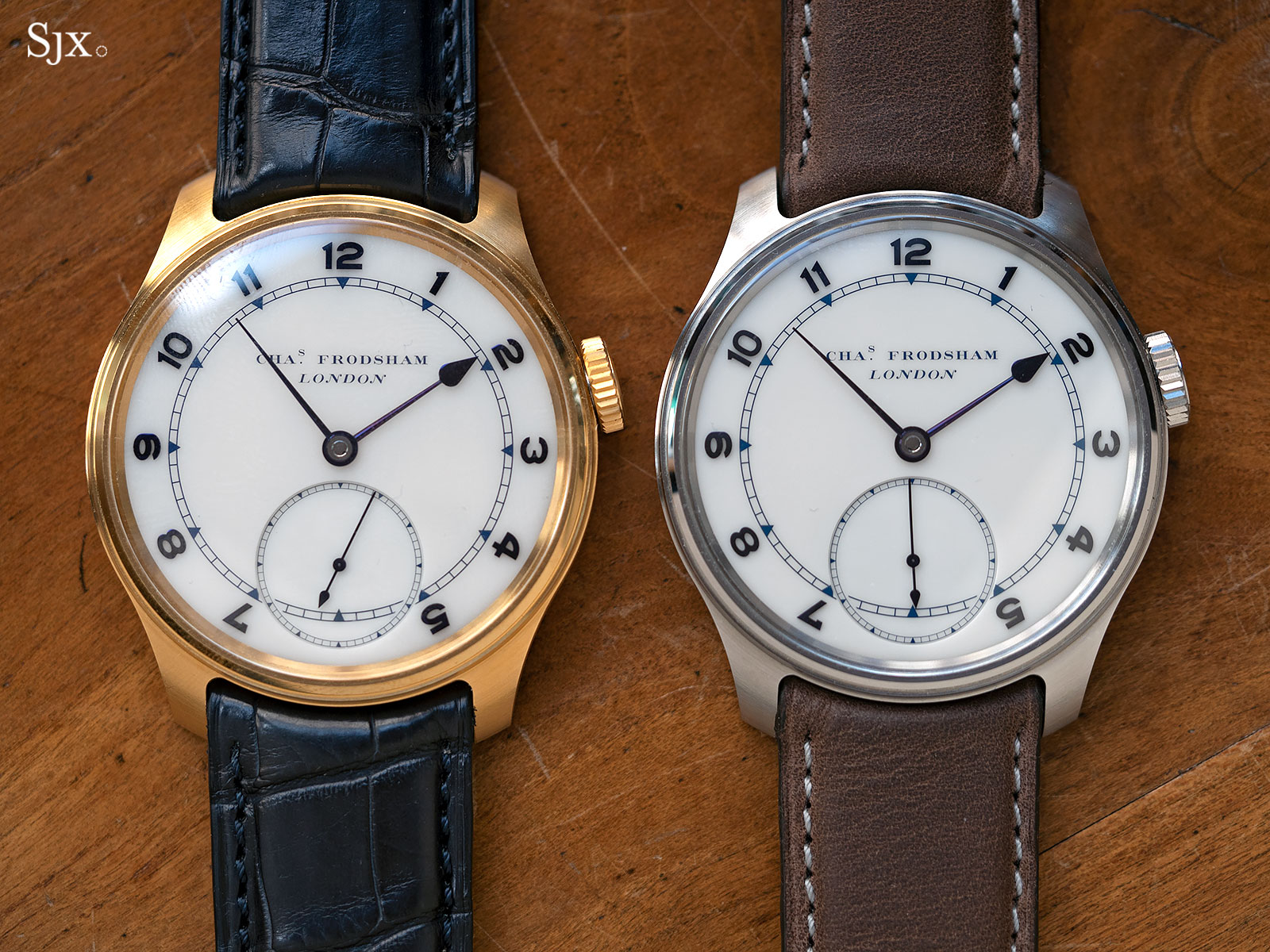
Almost all of the watch is made in-house by Frodsham at its workshop, which is staffed by seven watchmakers. The sapphire crystals, mainsprings and O-rings are obtained from Switzerland, while the wire for the hairspring is made by a European supplier, though its overcoil is formed by hand at Frodsham. Notably, even the jewels are in-house, being “new old stock” rubies originally made for small pocket watches many decades ago.
The entirety of the watch has been built to a unyielding, and somewhat old fashioned, philosophy that recalls high quality engineering of anther era. “With all the decisions taken over the watch,” says Mr Whyte, “[If] we have never yet found a valid reason to sacrifice mechanical integrity, [then mechanical integrity] must always come first.”
A lengthy process of trial and error in finishing and construction entailed the philosophy. And that, along with several projects Frodsham took on, including replicas of John Harrison’s H3 and H4 marine chronometers, along with a custom clock for Queen Elizabeth, meant that the Frodsham wristwatch took some 16 years to come to market.
The long road
Both the owners of Frodsham have been in watchmaking all their lives. Richard Stenning is a watchmaker who worked at Sotheby’s watch department from the 1980s – when antiquarian horology was all the rage – until he departed to take over Frodsham. Philip Whyte on the other hand, was briefly an auditor in the civil service, but has now been involved with watches for almost 50 years. Mr Whyte is now also a member of the advisory committee of the George Daniels’ Education Trust, a charity set up to fund horological education in the United Kingdom.
The concept of the Frodsham wristwatch is also in many ways reflective of the Messrs Whyte and Stenning’s background in watchmaking. For many watchmakers who came of age in the 1970s and 1980s precision chronometer wristwatches were the holy grail – the tourbillon regulator was still looked up to back then – which is why so many of them experimented with escapements (the most famous being the Daniels Co-Axial), and nearly all of them produced tourbillons.
The idea of the Frodsham watch came about in the early 2000s, when Messrs Whyte and Stenning decided to produce a contemporary wristwatch equal in quality and concept to pocket watches the company was famous for. While it is today difficult to comprehend Charles Frodsham’s reputation in its heyday, the firm was the leading English watchmaker during a time when the sun never set on the British Empire. That’s evidenced by the fact that financier J. Pierpont Morgan, the original J.P. Morgan, who along with his father and son were fans enough of the brand that they bought some 50 Frodsham pocket watches between them, many of which were gifted to partners of the various Morgan banks.
Messrs Whyte and Stenning wanted to revive of that glory, by producing the firm’s first ever wristwatch. Given Charles Frodsham’s historical prowess in precision timekeepers, including marine chronometers, the obvious route was to do something similar in wristwatch form, which naturally meant a detent escapement.
But detent escapements rarely work reliably in wristwatches, being vulnerable to stopping when subject to shock because of their single impulse action. This was proven by several prototype Frodsham watch movements featuring detent escapements that worked well most of the time, but not all the time.
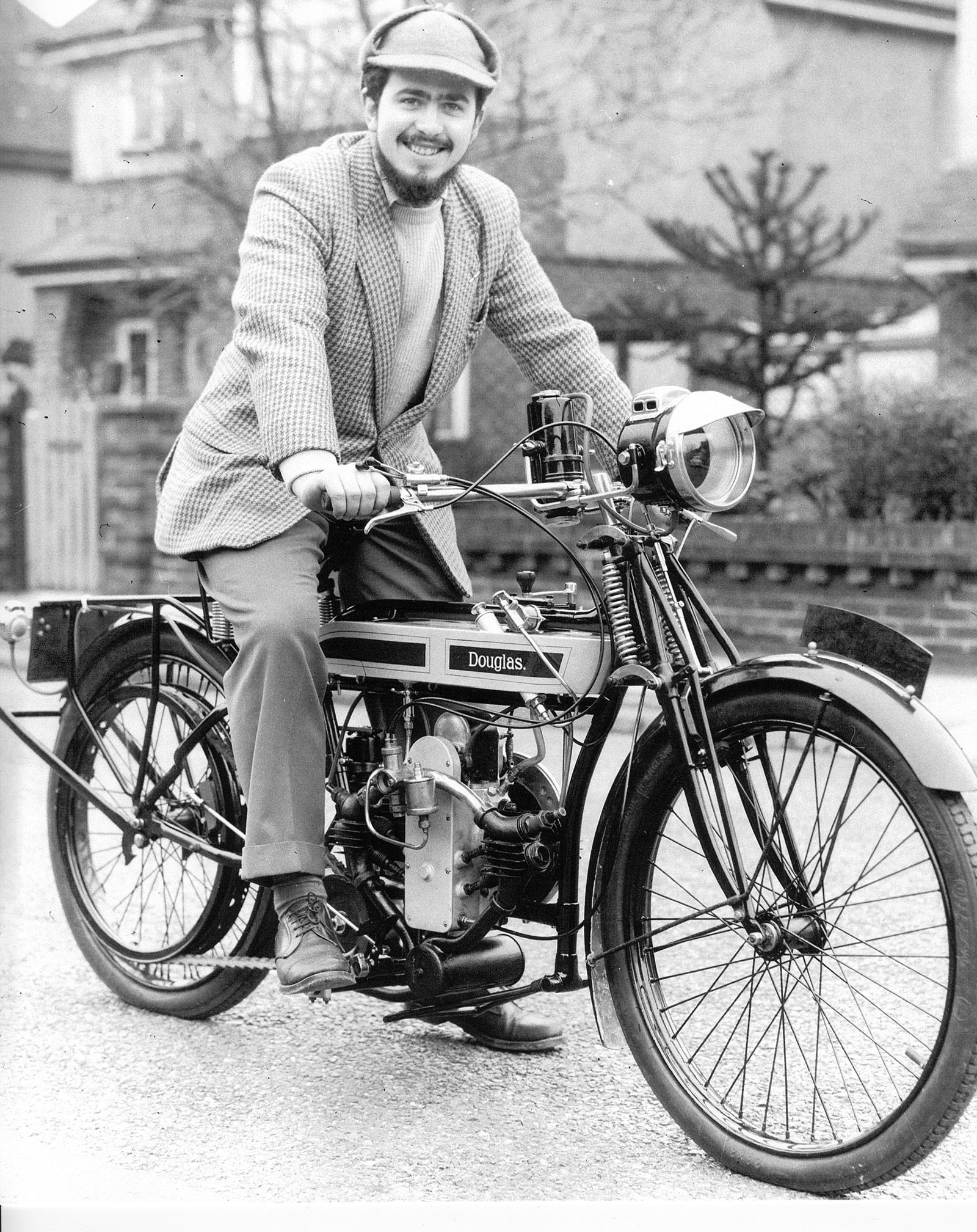
Derek Pratt in the 1960s
At Derek Pratt’s suggestion in 2004, Frodsham went with the double impulse chronometer escapement instead. It was invented by George Daniels, who was inspired by Abraham-Louis Breguet’s échappement naturel, or “natural escapement”, but developed with significant help from Mr Pratt.
Though never officially part of Charles Frodsham, Mr Pratt provided invaluable input, just by nature of his personality. Mr Whyte in particular was good friends with Mr Pratt, being contemporaries in age. When Mr Pratt became too ill with cancer to complete his replica of John Harrison’s H4 marine chronometer, he tasked Frodsham with finishing the monumental project.
Like many ideal escapements, the double impulse chronometer escapement operates with almost zero friction thanks to the tangential or radial contact between the escape wheels and the detent in between. And as the name suggests, is propelled by twin impulses rather the single, unidirectional impulse in a detent escapement. Each escape wheel is driven an independent wheel train and barrel, which provides for extremely consistent motion of the escape wheels and stable timekeeping.
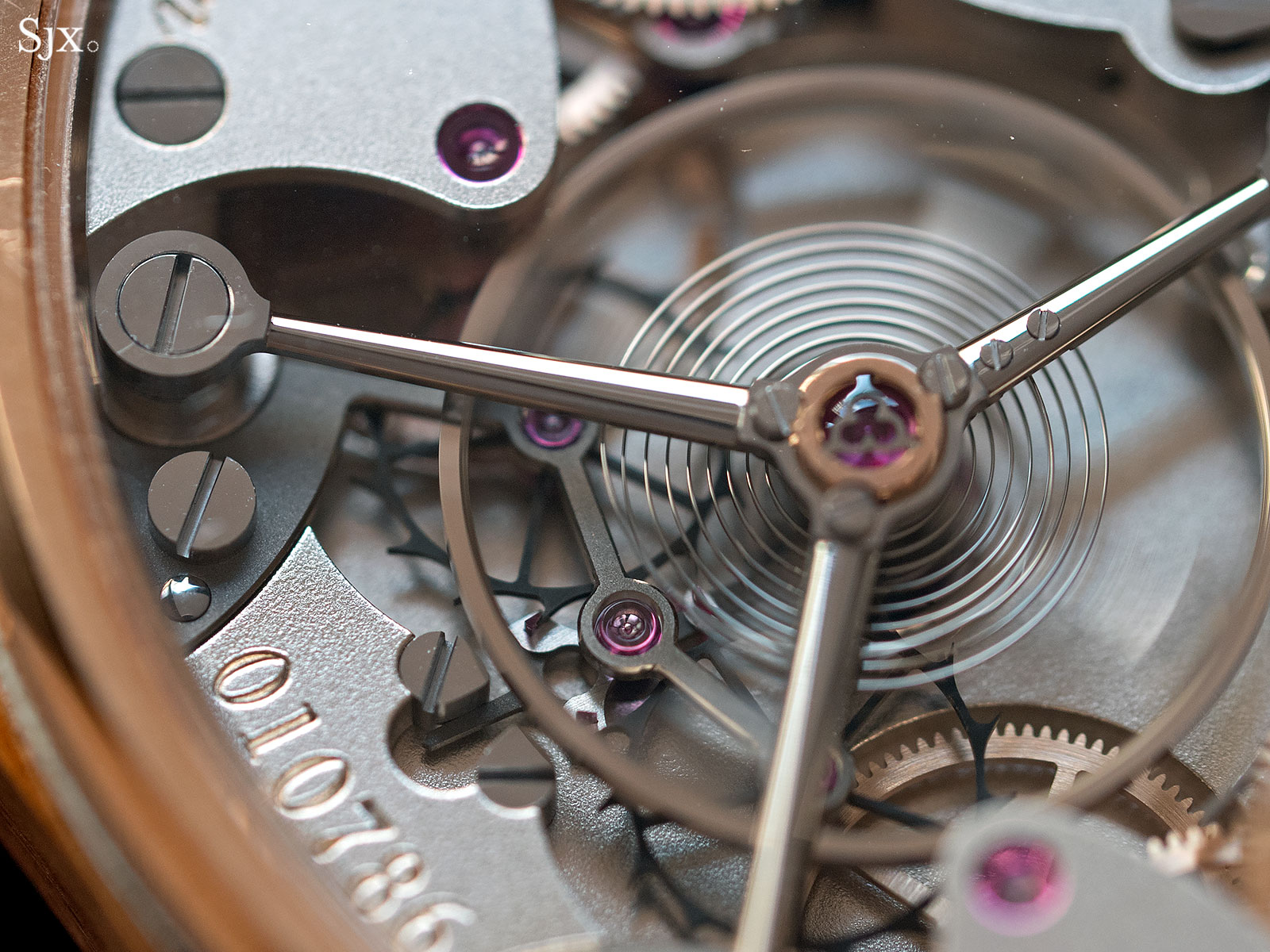
The tiny titanium detent visible in between the twin escape wheels of the Frodsham wristwatch
Derek Pratt, describing the double impulse escapement in Horological Journal in 2009, wrote: “The escape wheels move alternately, the inertia is low and the lockings are secure. The escapement is extremely lively in action and also very elegant.”
Mr Daniels used the double impulse chronometer escapement in several of his timepieces, including the landmark Space Traveller’s watch, he never implemented it in a wristwatch, believing it was difficult to miniaturise and also in part due to his invention of the Co-Axial escapement, which he later sold to Omega. Likewise, Mr Pratt integrated the escapement in several of his pocket watches, but modified the construction to rely on a single train while putting both escape wheels on separate axes, which allowed him to combine the escapement with a tourbillon regulator.
The double impulse chronometer escapement in the Frodsham wristwatch is, in many respects, the realisation of an idea developed by three watchmaking talents over two centuries – Breguet, Daniels and Pratt.
The case
The Frodsham watch is large but simple on the front, looking and feeling like a proper, formal and high quality watch. The style is eminently classical save for the unusually positioned crown, which was a necessity of the movement.
“To accomodate the hidden up and down mechanism [and the large seconds indication in its ideal position]… the winding stem needs to be offset by 15 degrees,” explains Mr Whyte, “Although it is theoretically possible to force the stem to be at the conventional position, this would have required to make many of the watch components smaller and thus going away from the ideal proportions.”
The case is well proportioned, not too thick, at 42.2mm in diameter and 10.5mm. The narrow bezel and white dial make it seem larger than it is, though not overly so.
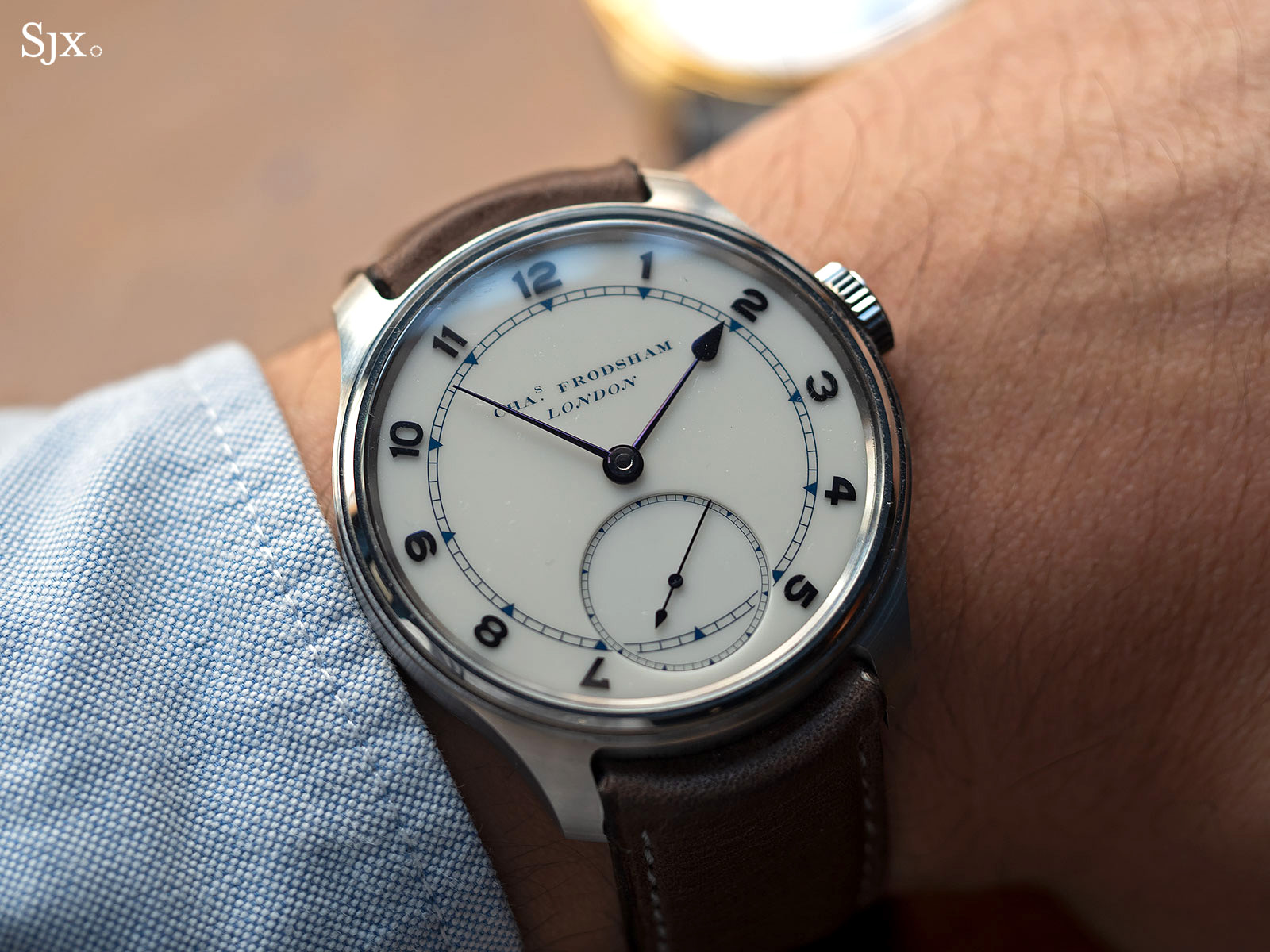
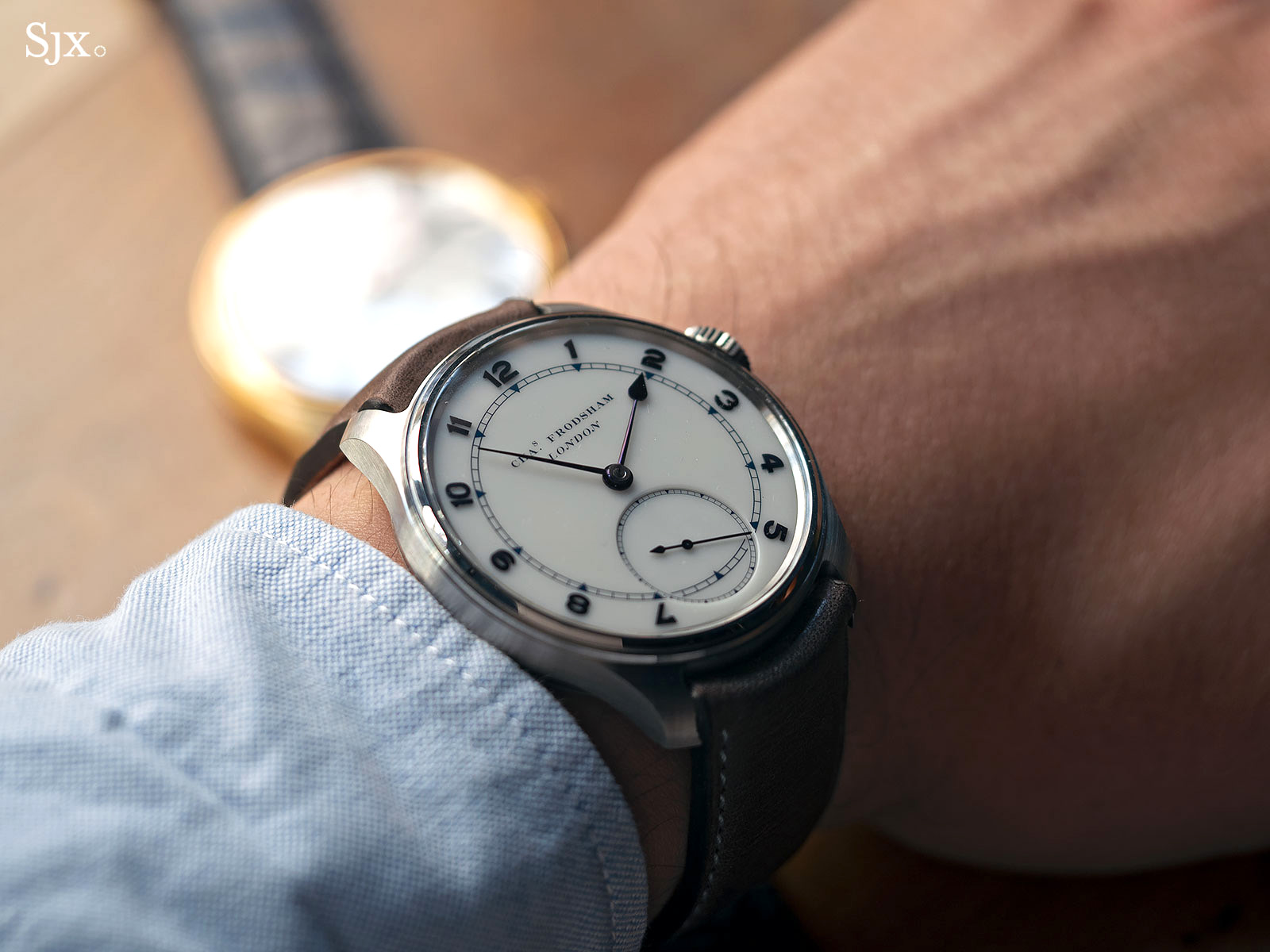
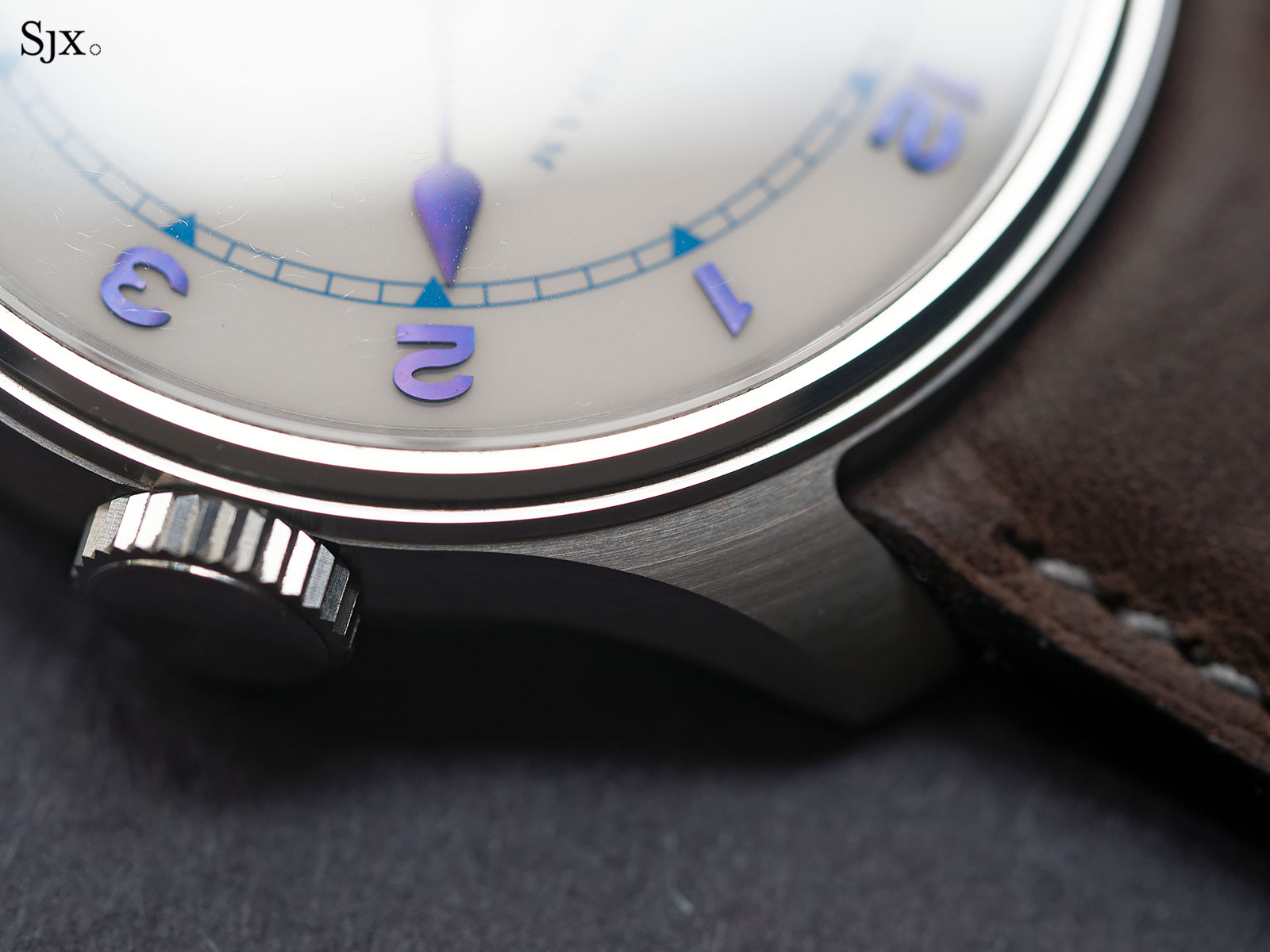
Most of the case surfaces are neatly finished with a linear, brushed finish, while the bezel is sharply formed and polished. Though the form and finish is simple, it is well executed and high quality.
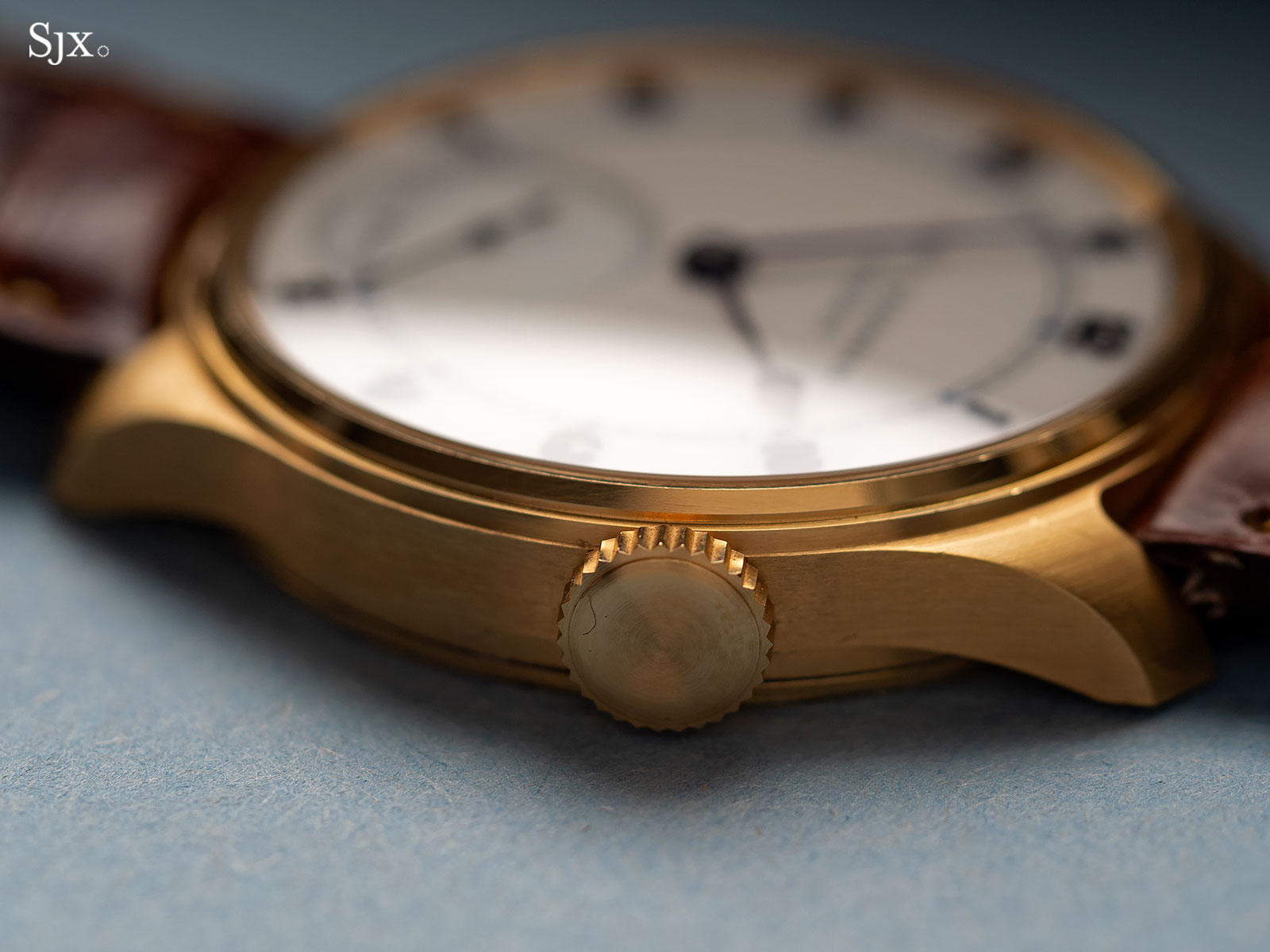
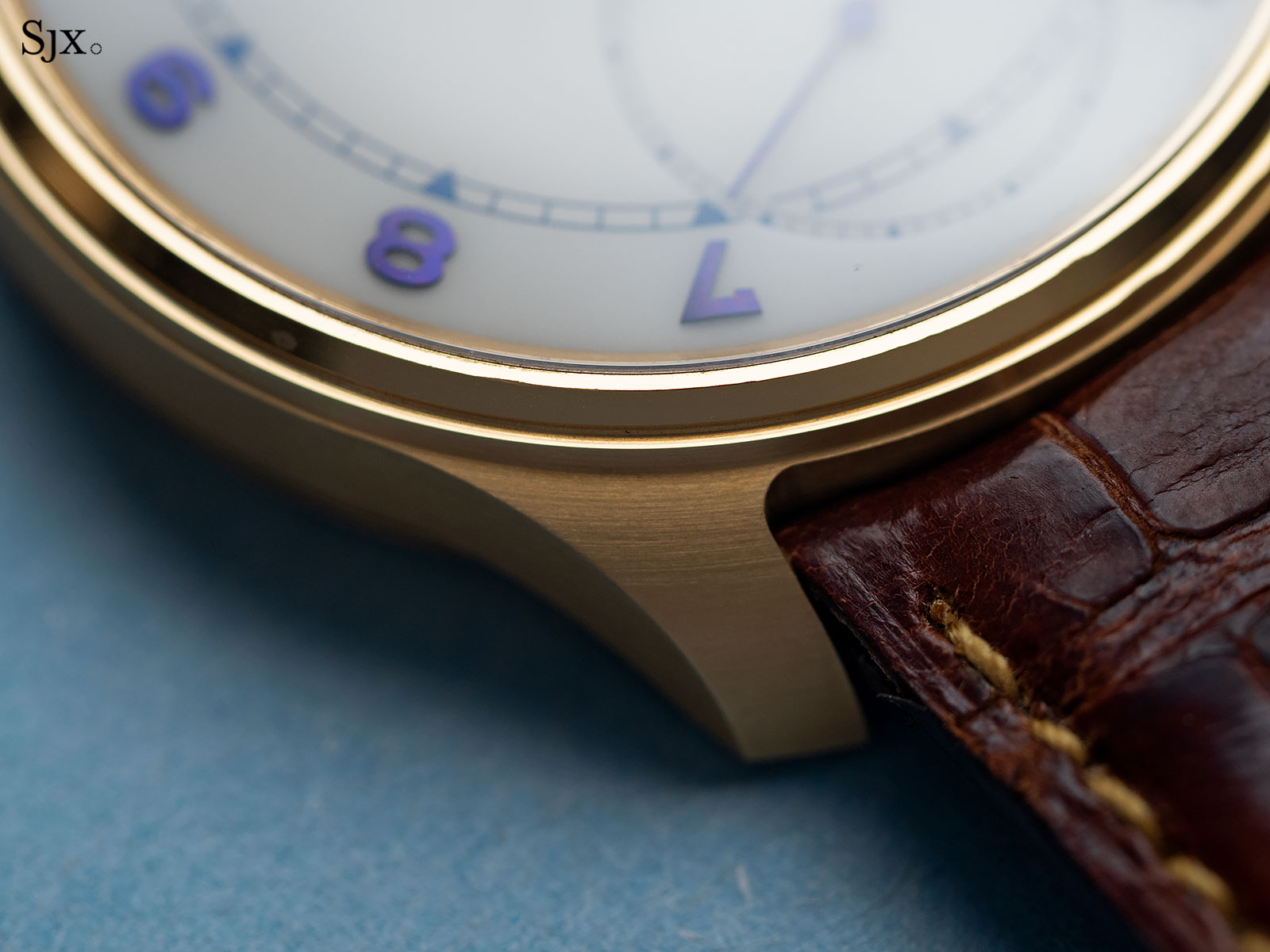
It’s available in steel, 18k white or rose gold, as well as 22k yellow gold. All the precious metal cases are hallmarked on the back of the lugs, and the prominent assay marks add to the Englishness of the watch. The crown indicates the metal is gold, while the leopard’s head means it was struck by the Goldsmiths’ Company in London, which has been using the hallmark since 1300.
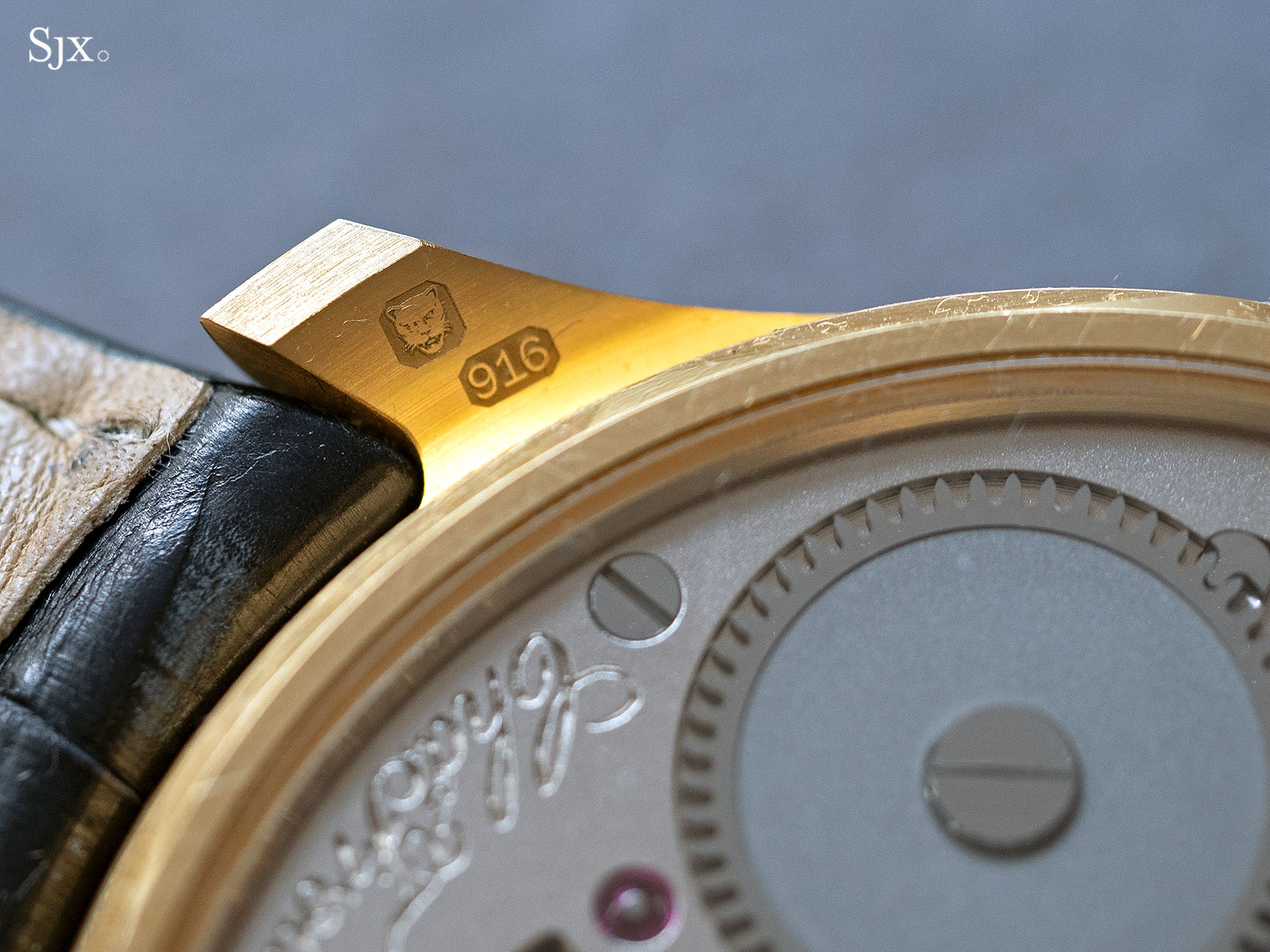
“916” indicates 22k gold.
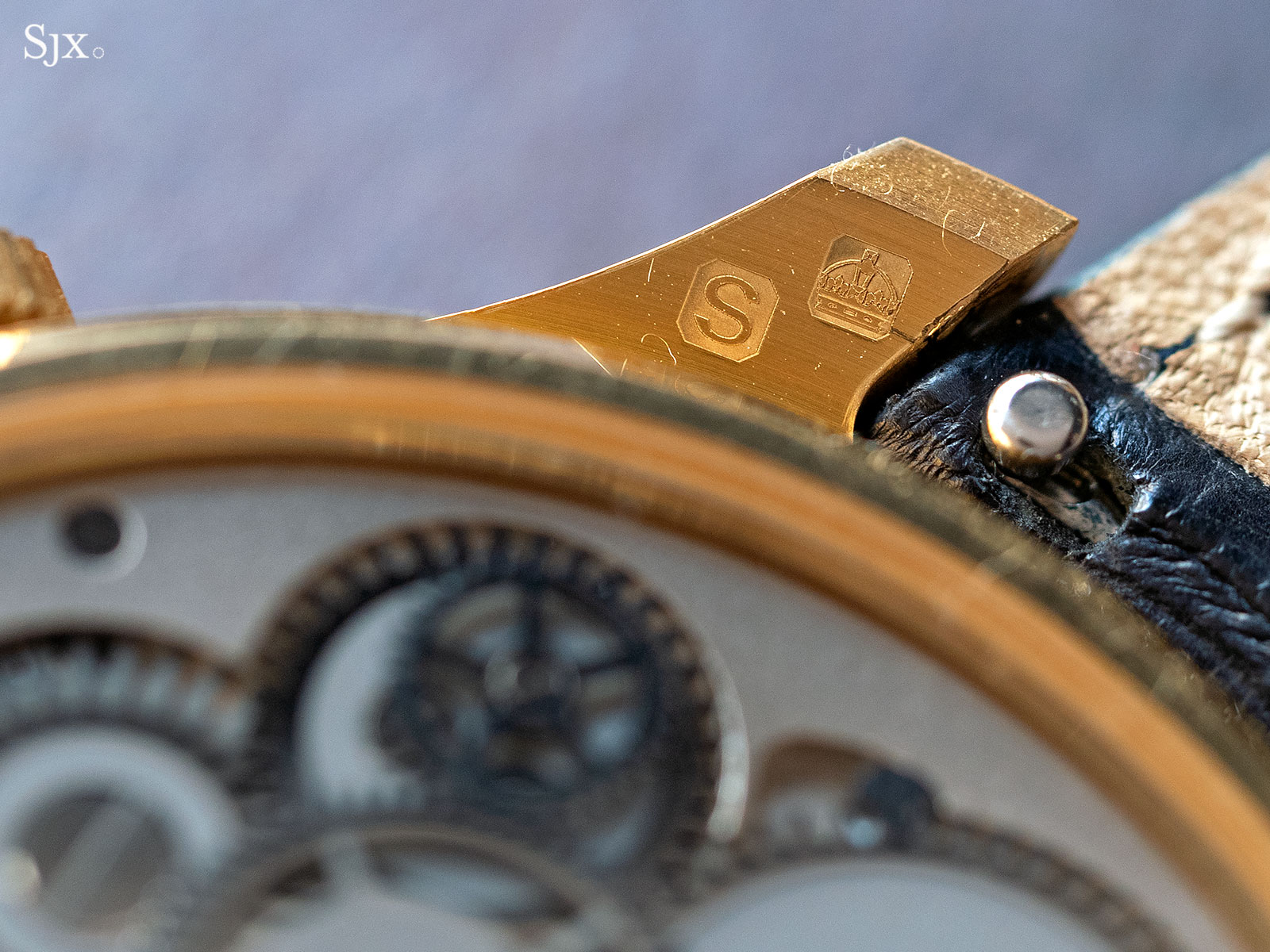
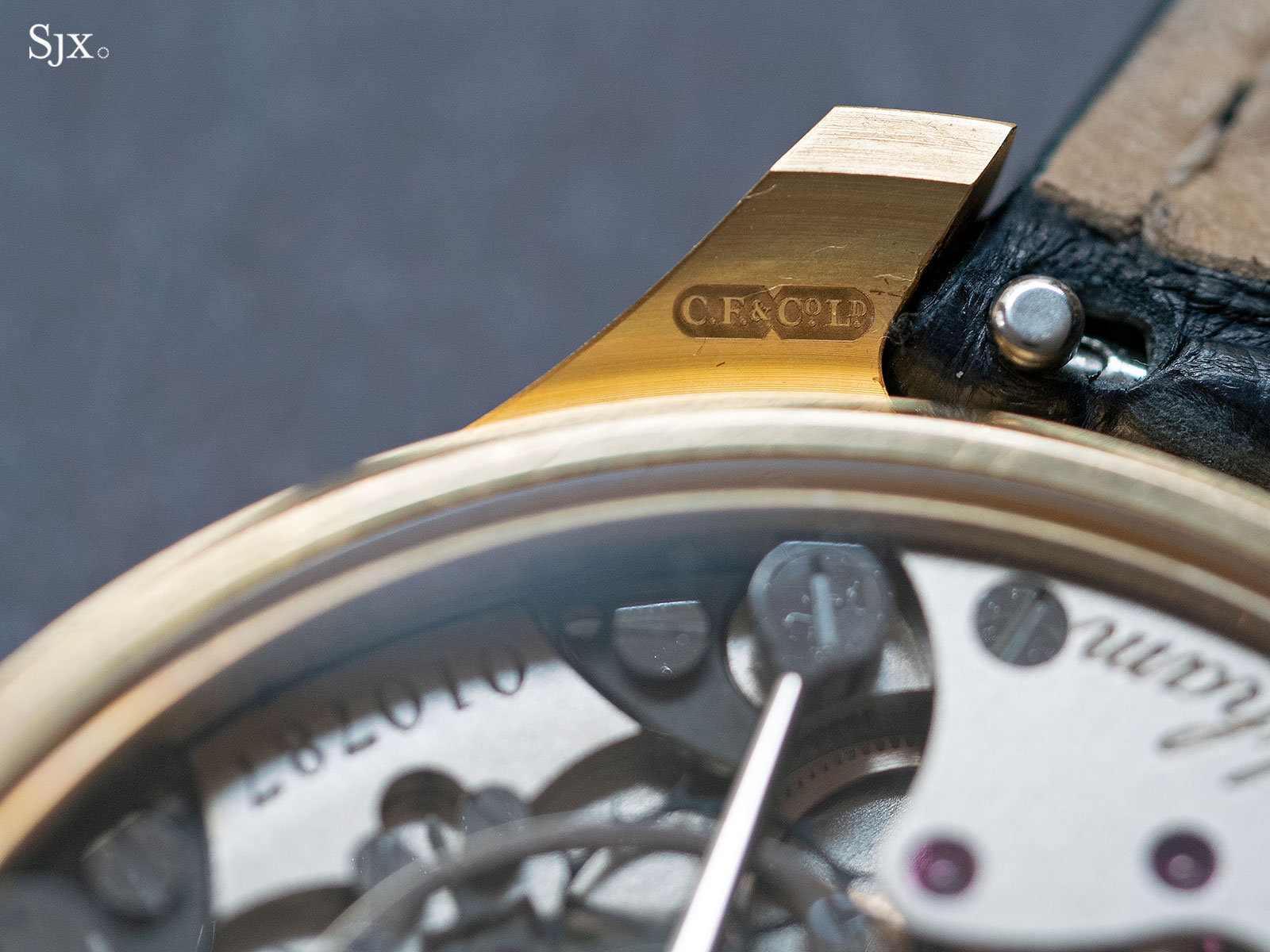
It is the priciest option, but the 22k gold case is intriguing, being strikingly yellow and having a significantly higher gold content – 91.6% versus 75.0% – than conventional 18k gold alloy. Though purer gold alloys are usually softer, the 22k gold case has the same surface hardness as ordinary 18k gold because of its two step production process. It’s first forged, or pressed into shape with great compressive force, and then hard rolled, which is akin to compacting between a pair of rolling pins.
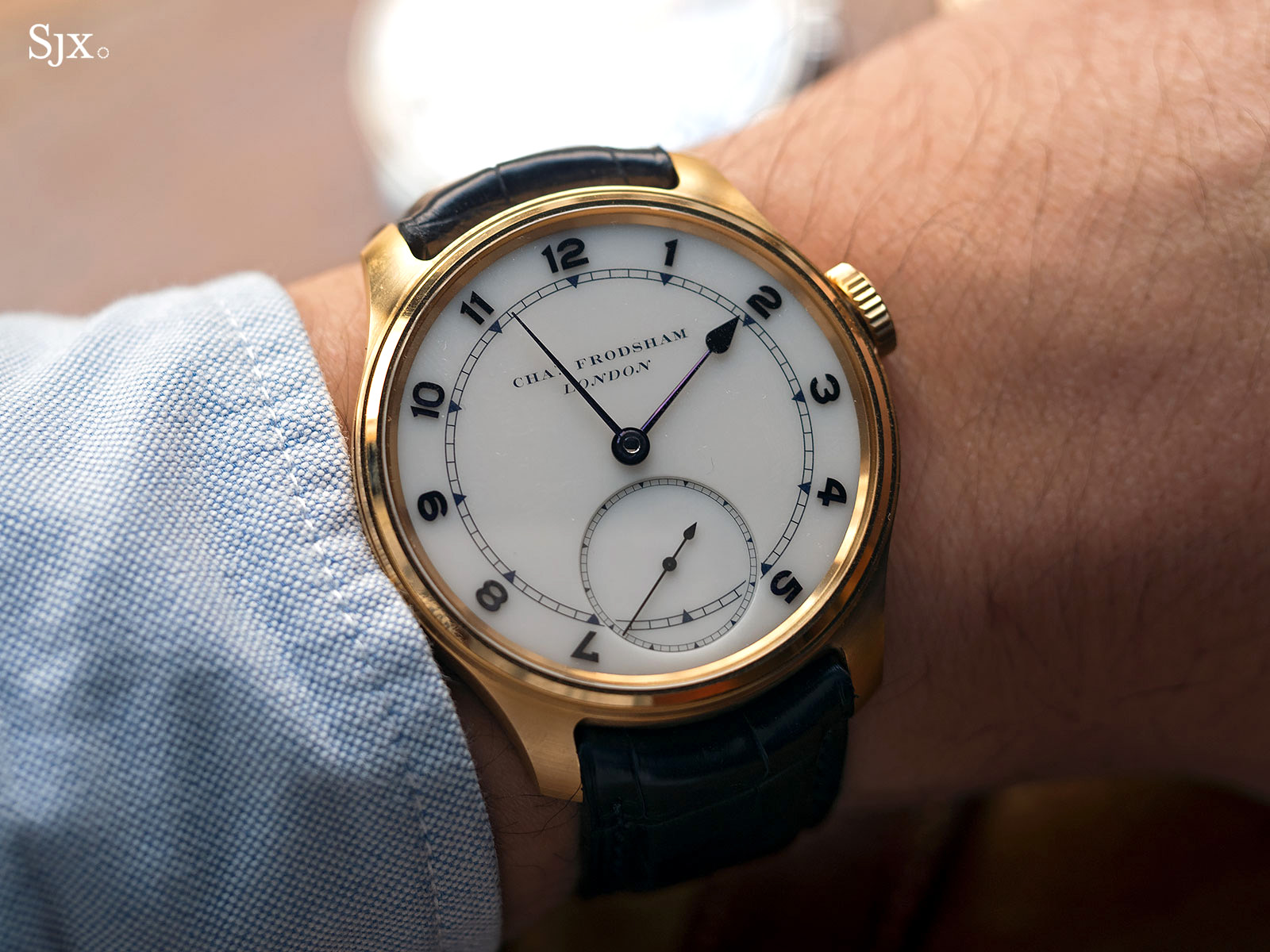
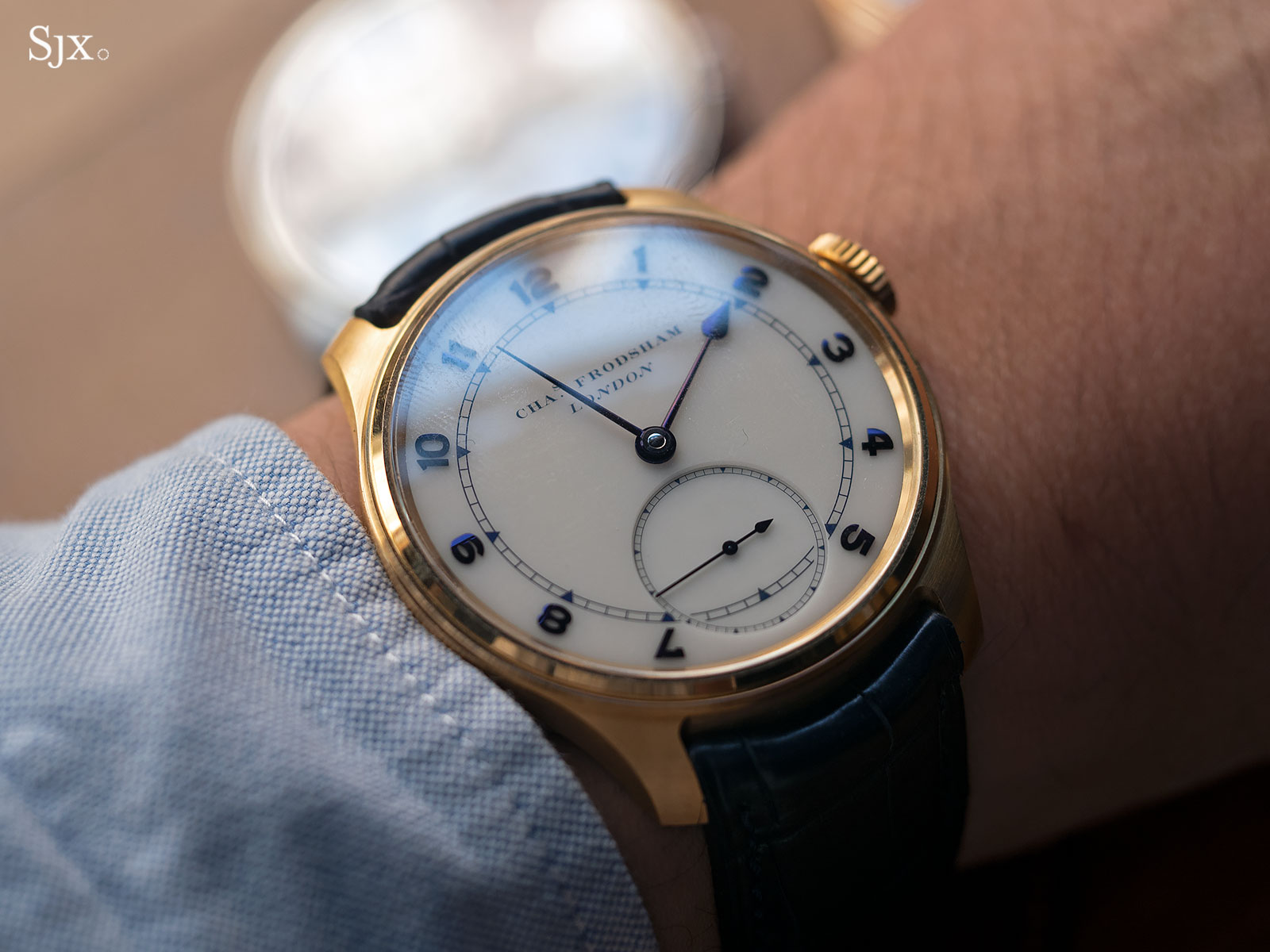
One detail of the case that illustrates the dedication to high quality construction is the tube for the crown. While most watches reveal a winding stem when the crown is pulled, the Frodsham wristwatch has a polished, hardened steel tube that completely encloses the stem, even when the crown is pulling out for winding or setting. This serves to protect the stem from impact, and also allows for two O-rings inside the crown.
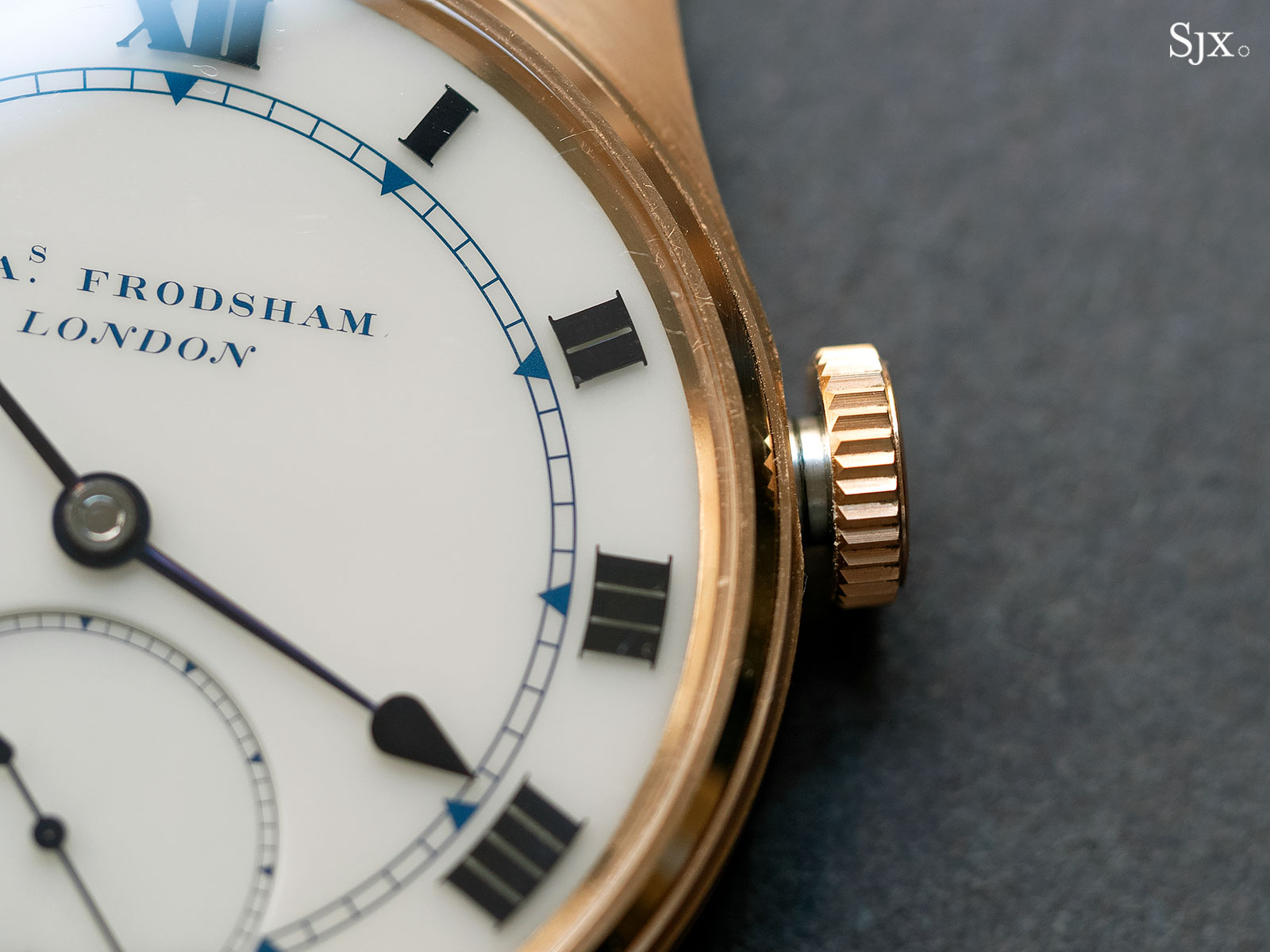
The dial
While simple in style, the dial is unusual in design and materials. To start with, the hour and minute hands are exactly the same length, having been modelled on a Frodsham tourbillon pocket watch from the early 1900s, which also served as the inspiration for the one-off clock made for Queen Elizabeth on the occasion of her Diamond Jubilee in 2012.
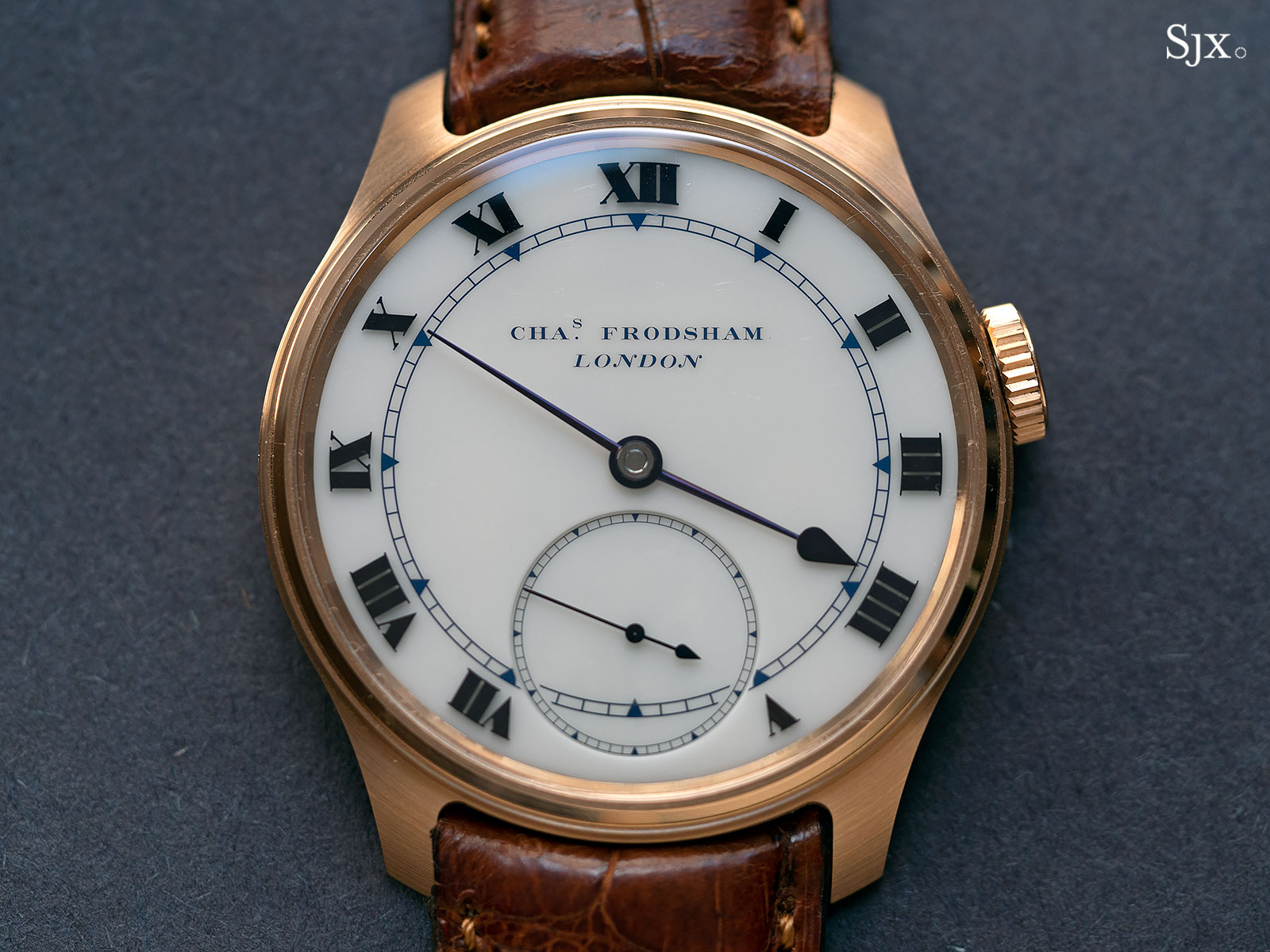
Though the dial appears to be enamel (which is melted glass powder), it is actually ceramic, specifically a type of zirconium dioxide. While traditional dial materials like enamel and porcelain are fragile and often develop cracks over time, ceramic is much more durable. The dial should look exactly the same even after decades.
The fresh ceramic disc is too thick for a dial, so it has to be lapped to reduce it to the required thickness, and then given a fine surface that is almost glassy smooth. A dial is actually made up of two ceramic discs stacked on one another, which is why the seconds sub-dial sits in a recess with bevelled edges.
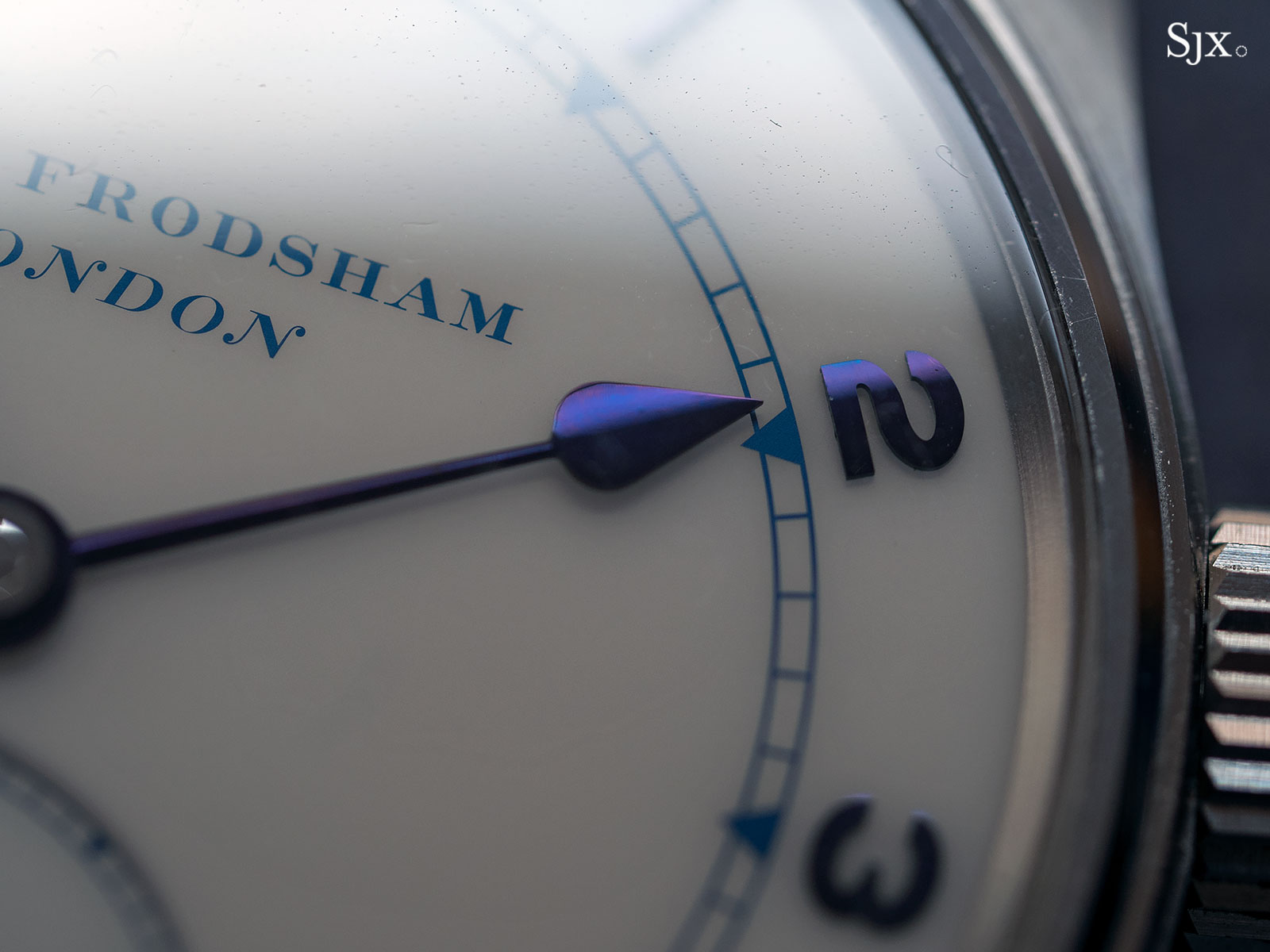
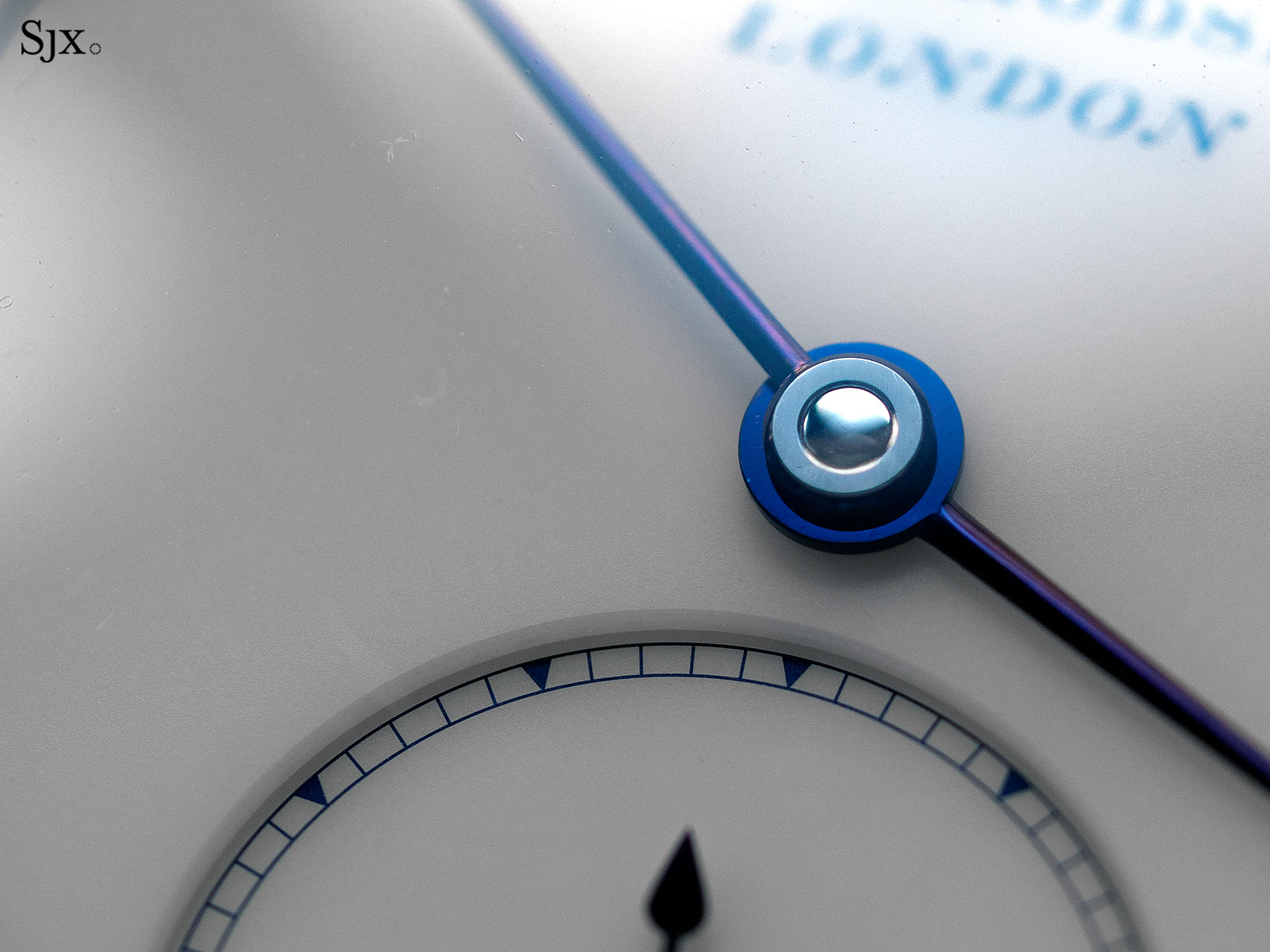
The dial is a strikingly pure and bright white, with a slightly translucent surface that’s only apparent up close from the shadows that the hour numerals cast on the dial, leaving the hour numerals seemingly floating on the dial surface.
All of the hour markers are blued steel, just like the hands, and possess a strong purplish-blue colour. According to Mr Whyte, the hands and hour numerals are each blued individually over a flame, which results in micro-variations under magnification, although they appear perfectly uniform on the dial.
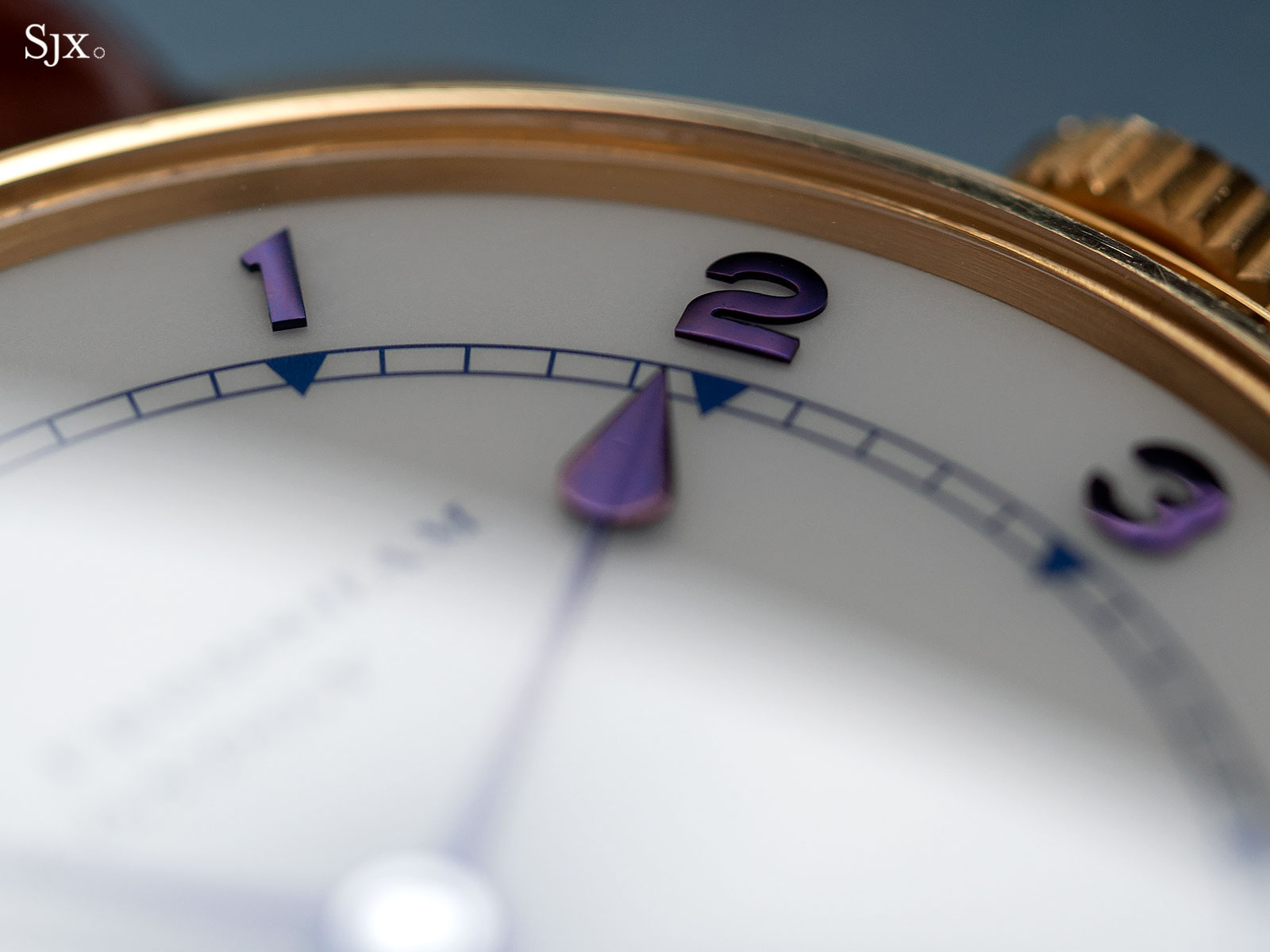
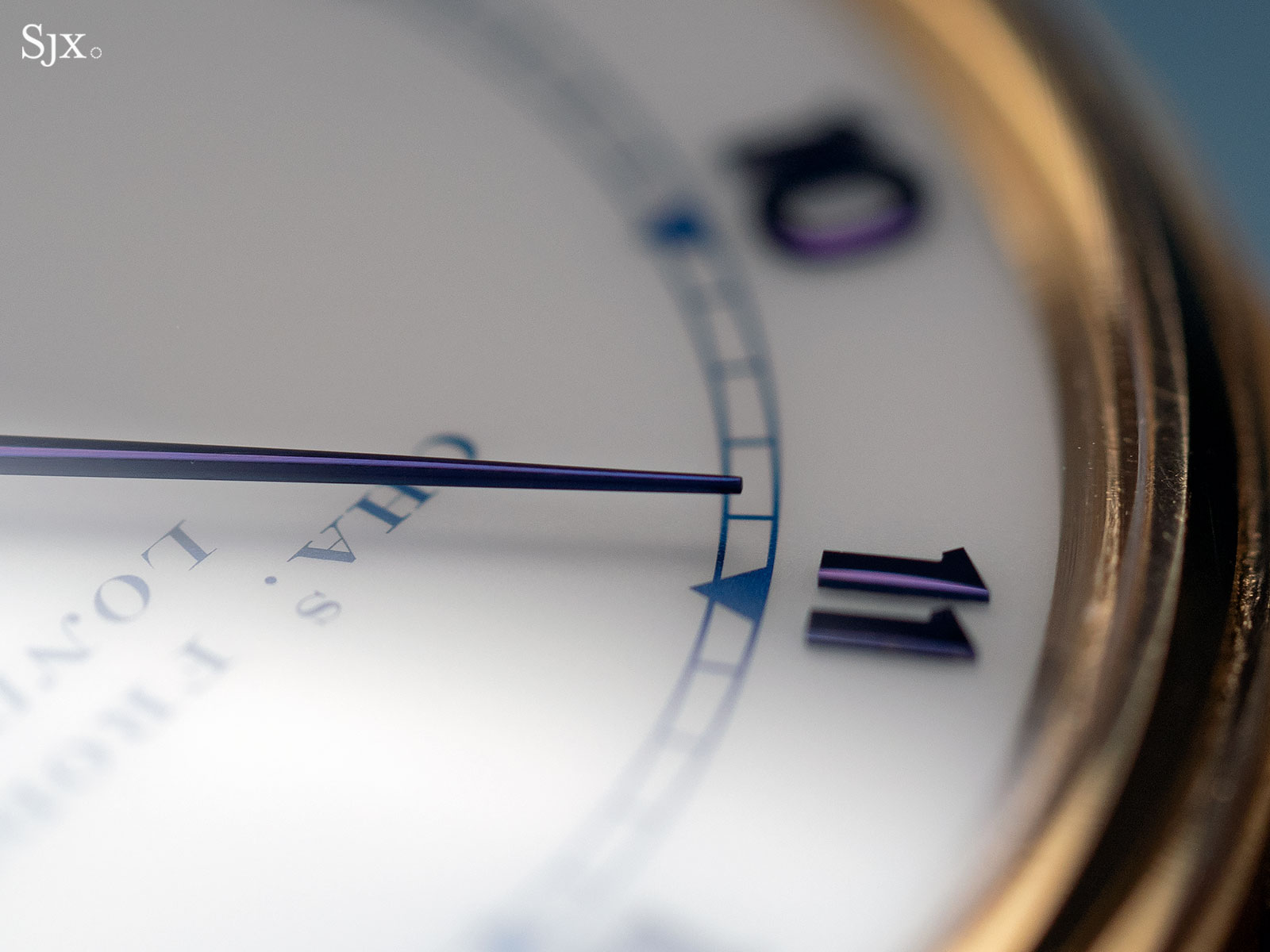
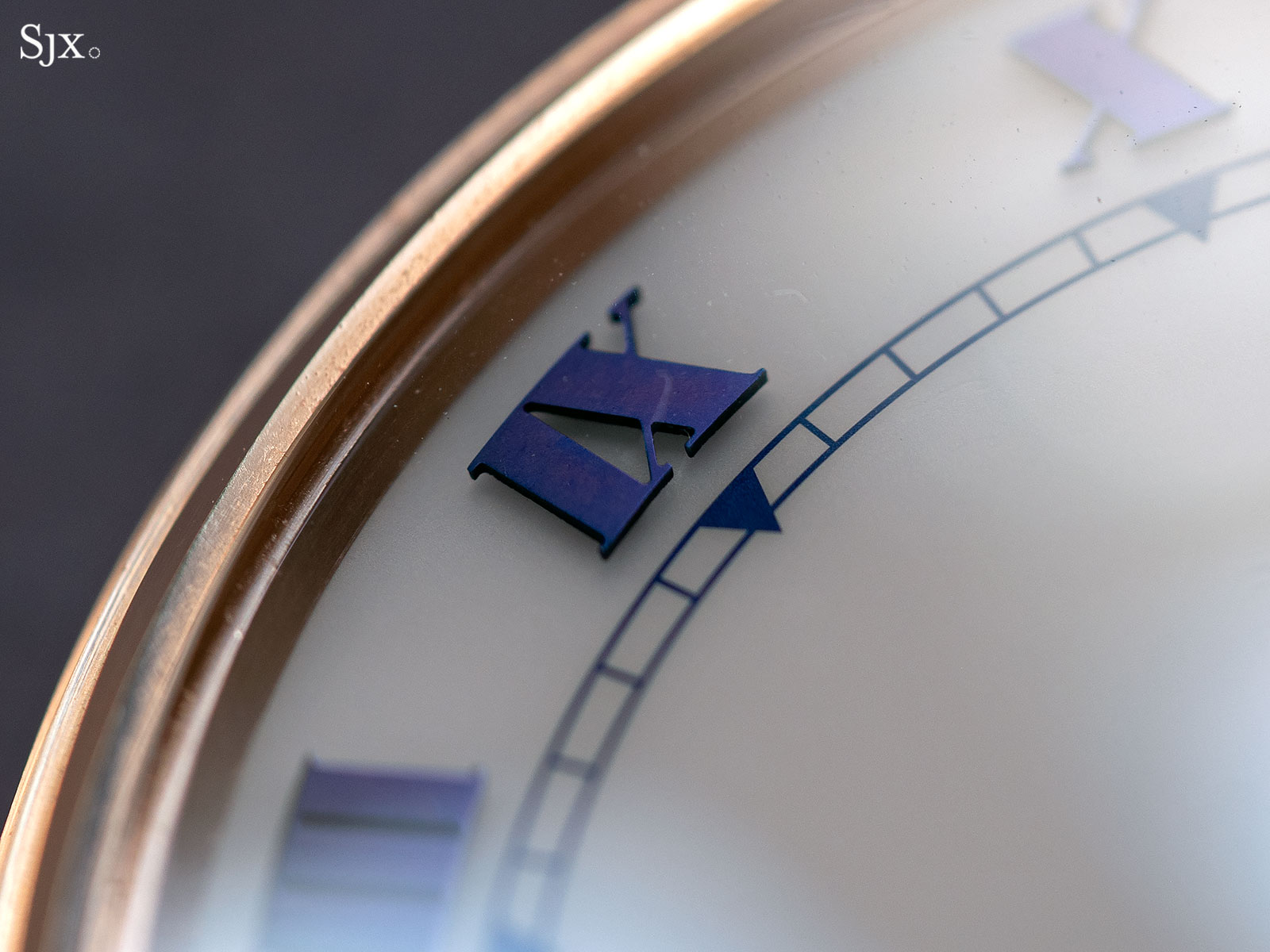
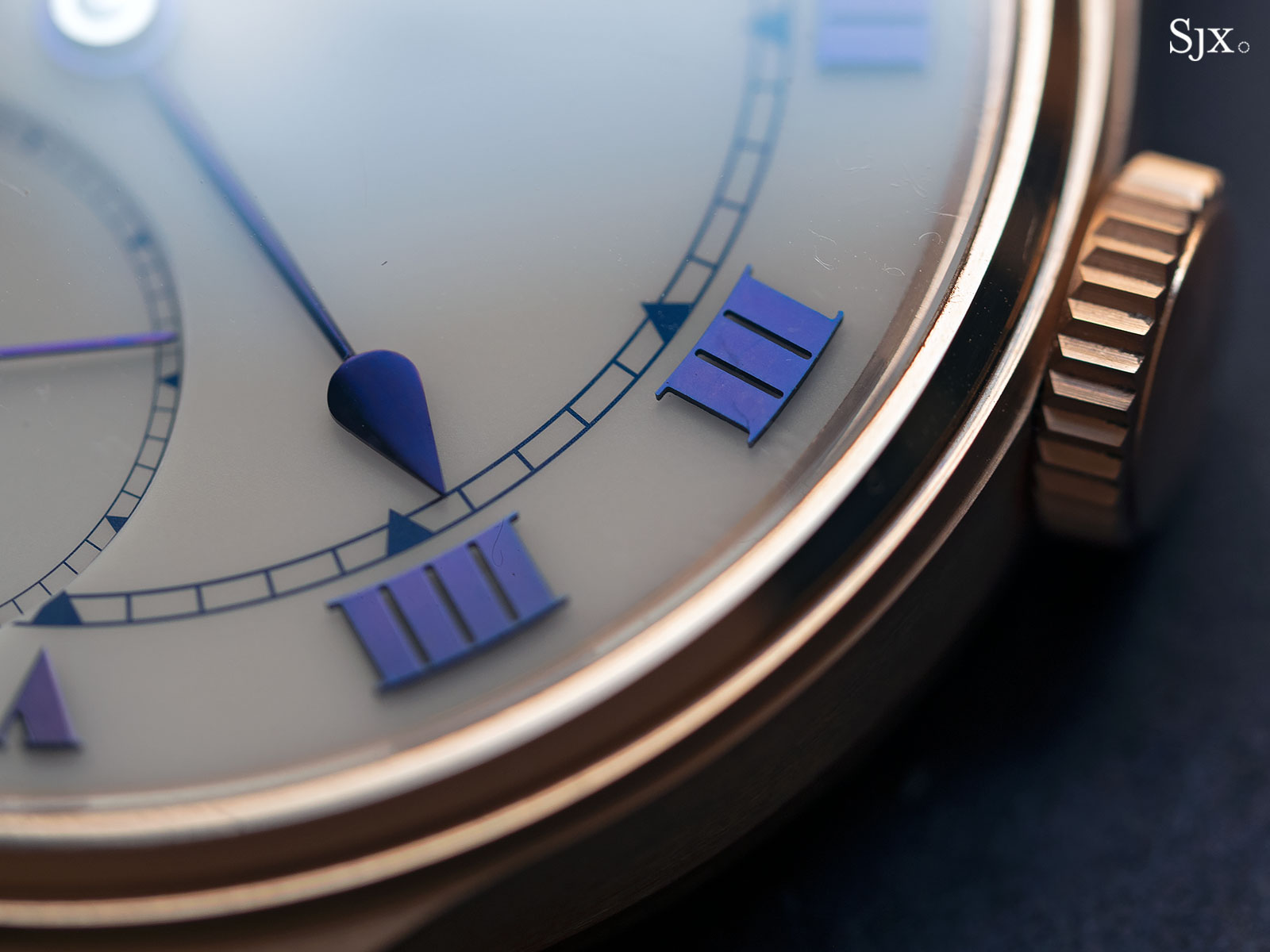
In contrast, the logo and tracks on the dial – the lines of the seconds register are a mere 12 microns wide, or less than a quarter of a human hair – are a more muted blue, being the result of vapour deposition of chromium oxide. It’s a highly technical process done by a specialist a few miles from the Frodsham workshop and comprises heating up the alloy in a vacuum, which turns it into a gas that can be then deposited onto the dial to create an extremely thin but indelible layer. Frodsham opted for this, instead of traditional pad printing, as the vapour deposition markings are fade-resistant, and will, like the ceramic dial, last essentially forever.
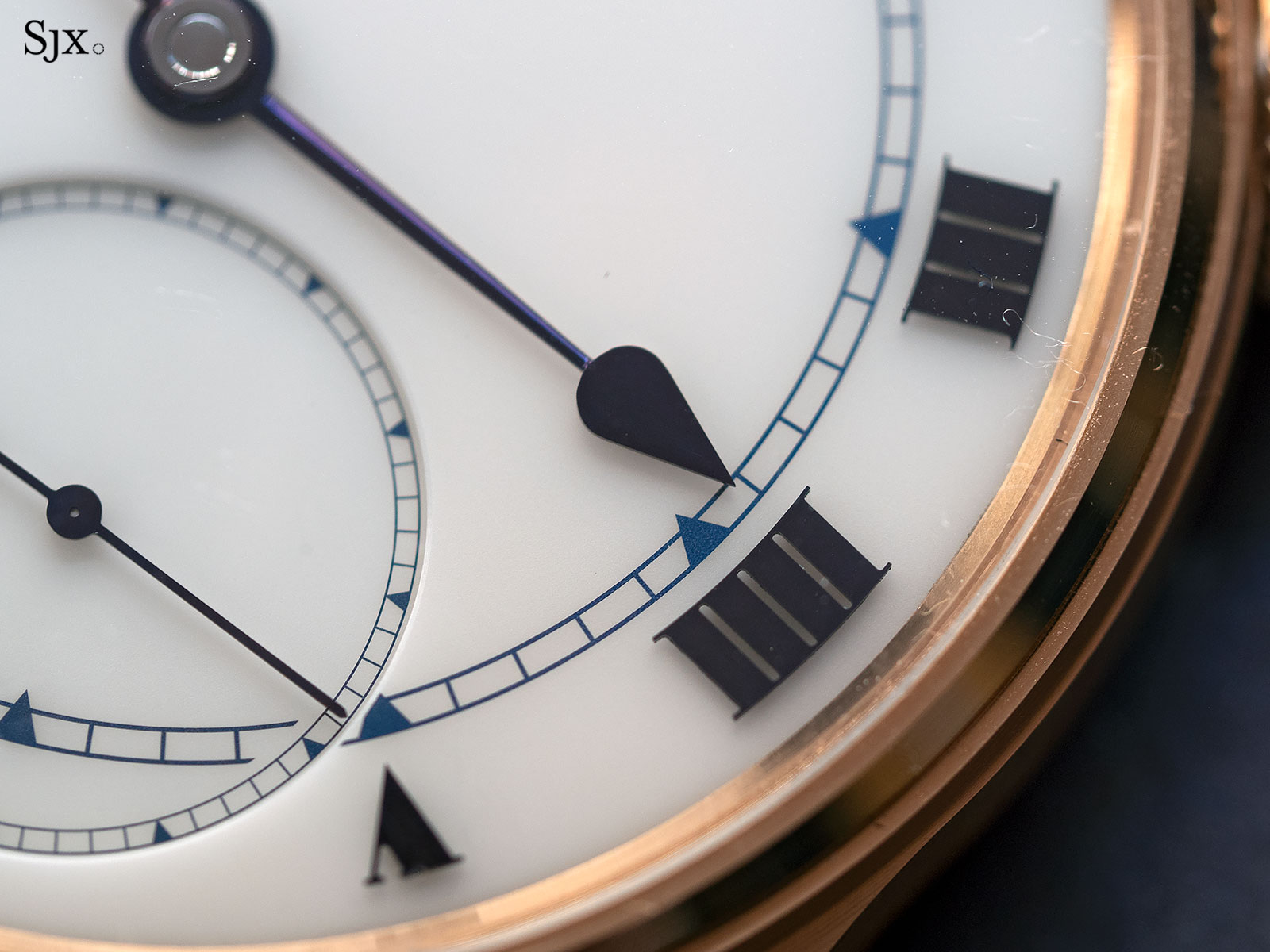
Two basic dial styles are offered, both being white ceramic with either Roman or Arabic numerals for the hours. There’s also the option, available upon request, of a pair of a honour cyphers on the dial. Visually the most appealing dial variation, the cypher dial has a distinct look with an accentuated retro-pocket watch flavour.
Like the tracks and logo, the cyphers are the result of vapour deposition. They are based on similar cyphers found on vintage Frodsham pocket watches that indicated the Royal Warrants or prizes Frodsham received over the years. Though most commonly found engraved on pocket watch movements, they were also placed on watch dials in the past.
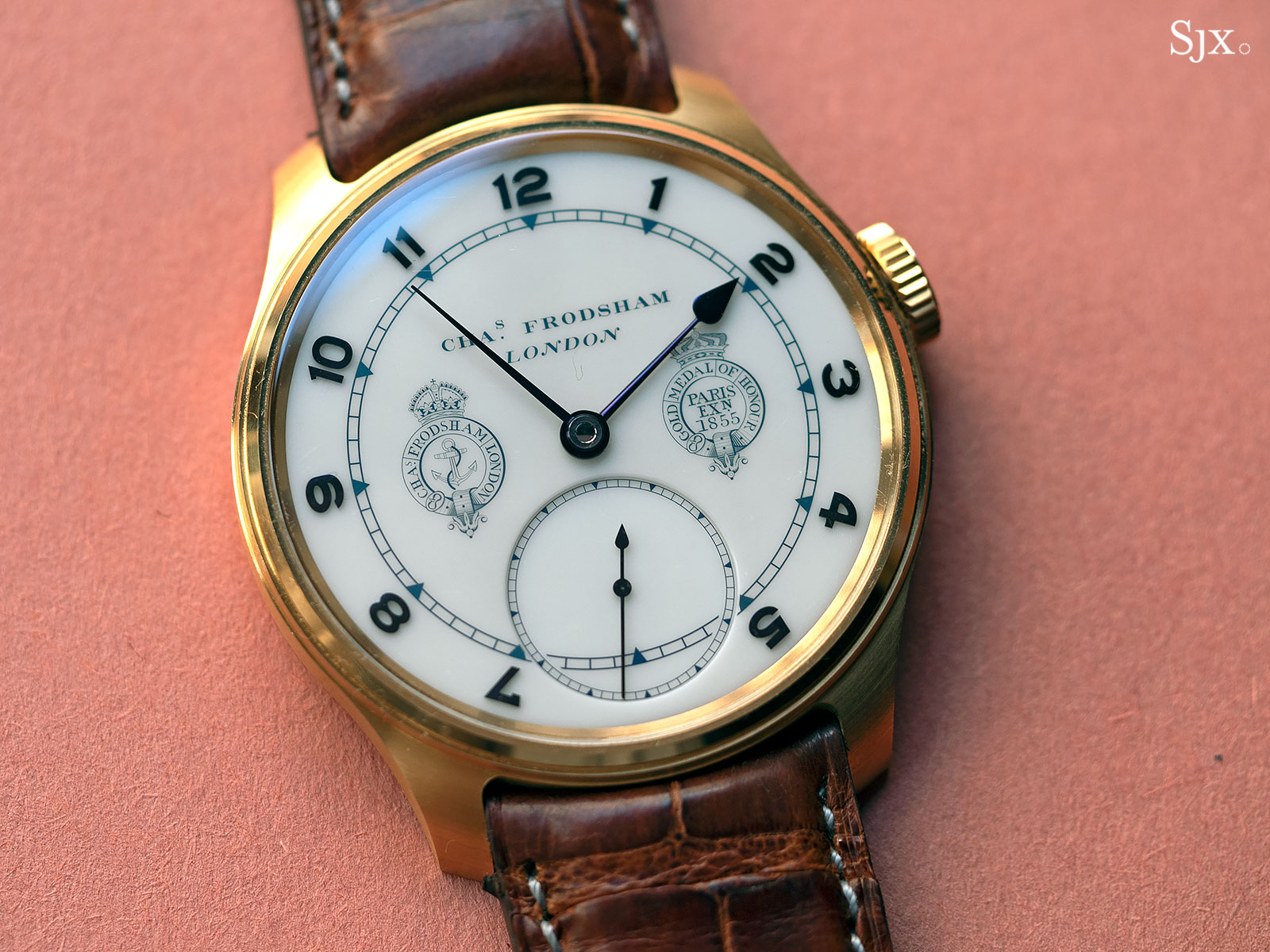
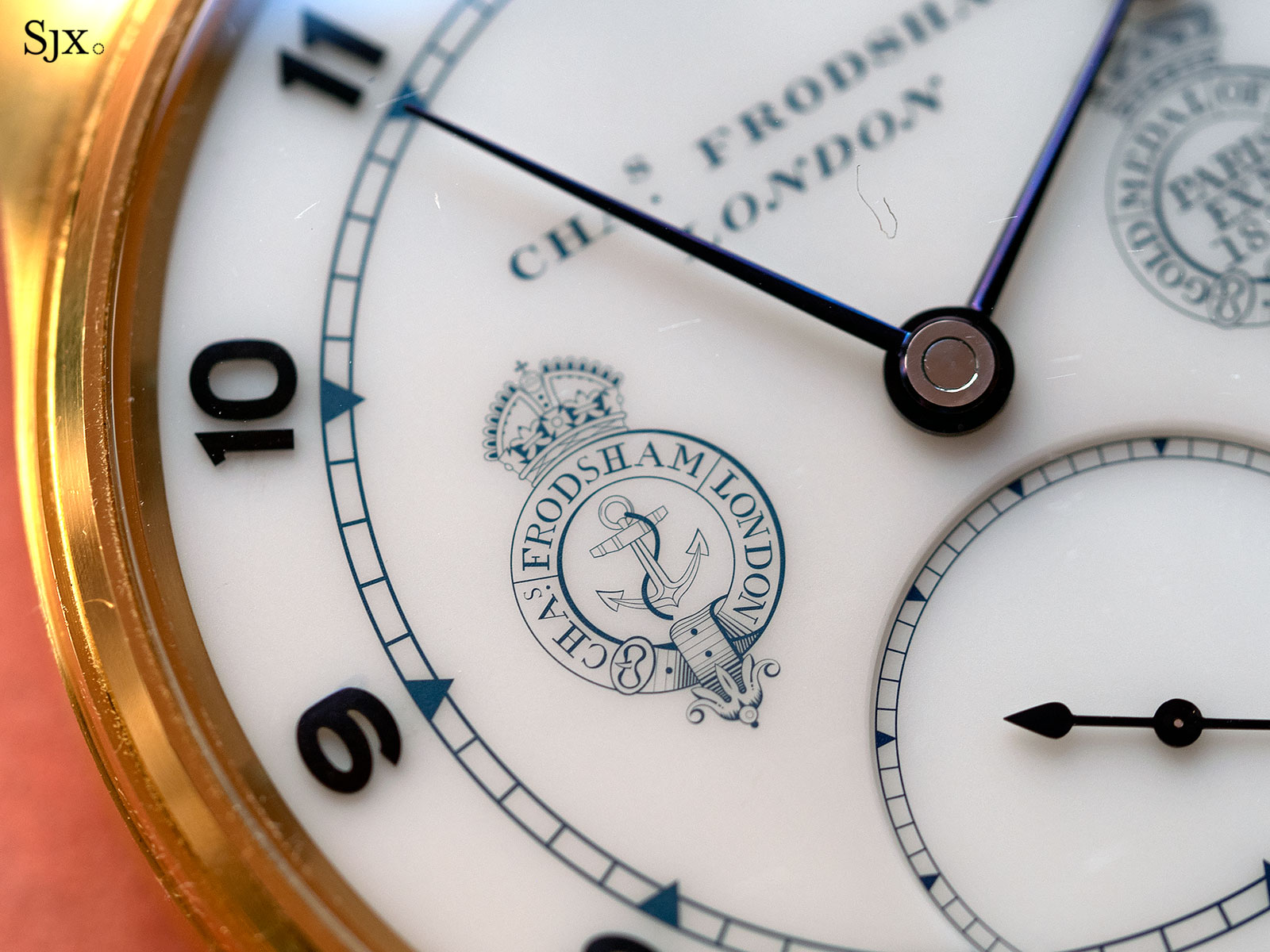
The movement
The movement is an impressive construction. It’s almost symmetrical in layout, with each barrel and wheel train on either side of the oversized balance wheel that’s secured in place by an impressively shaped steel bridge. A discreet power reserve indicator sits just over the winding wheels; though simple in display it relies on an epicyclic differential made up of 12 wheels.
On a full wind the watch will run for a fixed 36-hours due to a brake that stops the movement just before the barrels are completely empty, by touching a lever to the balance wheel, stopping it. The movement also has a second hacking mechanism that stops the balance when the crown is pulled to set the time, which takes the form of a lever with a pin at its end that stops the balance.
But the crucial feature of the movement is no doubt the double impulse chronometer escapement, which was a challenge to perfect.
“Tolerances in a detent escapement are generally more critical than in a lever escapement, since smaller clearances are required,” says Mr Whyte.
“In the double wheel escapement the challenge is furthermore increased by the fact we are basically dealing with two escapements. Whereas in a single detent adjustments can be made, in the double wheel escapement these adjustments are no longer possible, as they would affect the second half of the escapement. This means that the tolerances in manufacture and finishing are much tighter, than one would expect.”
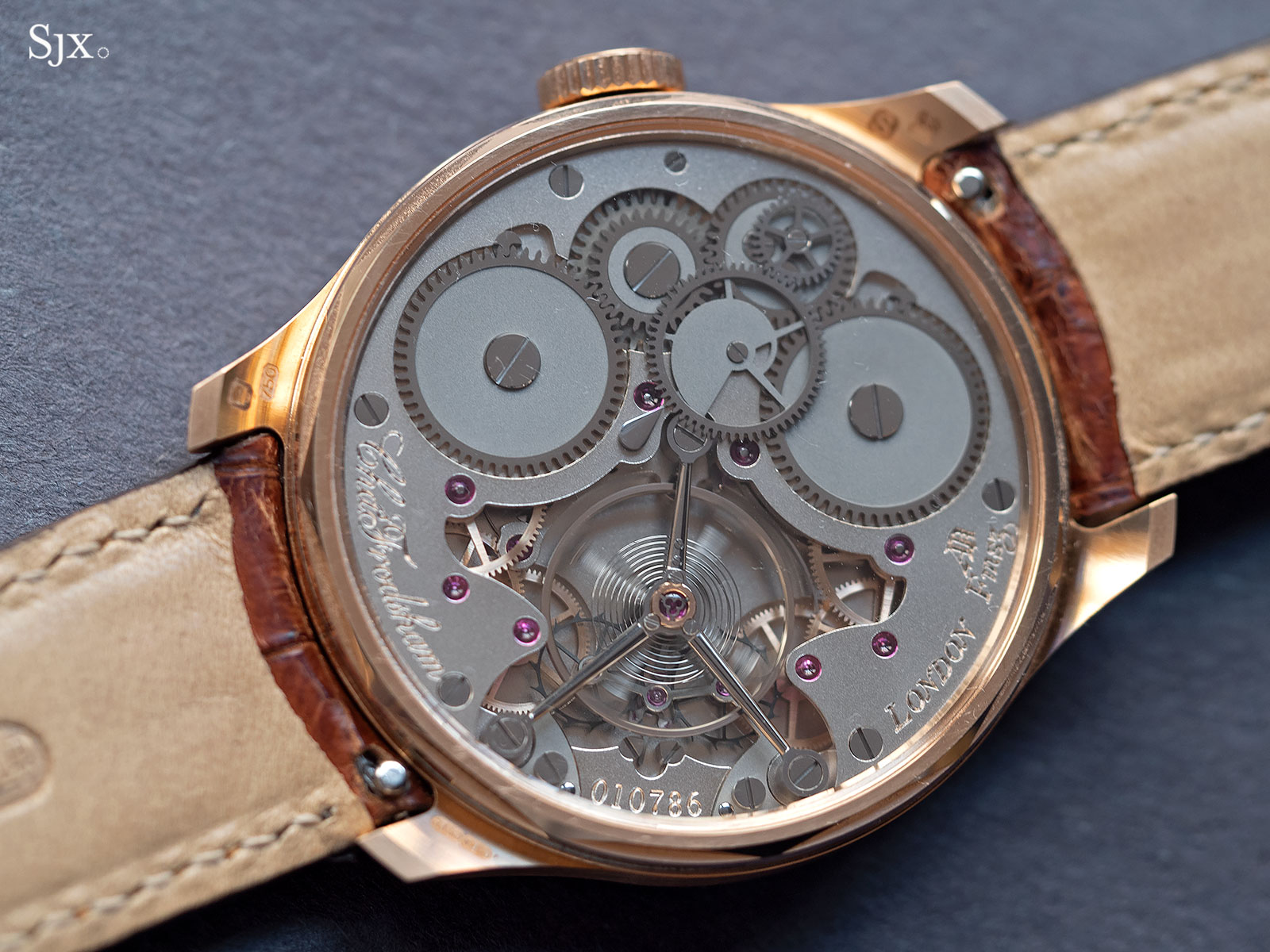
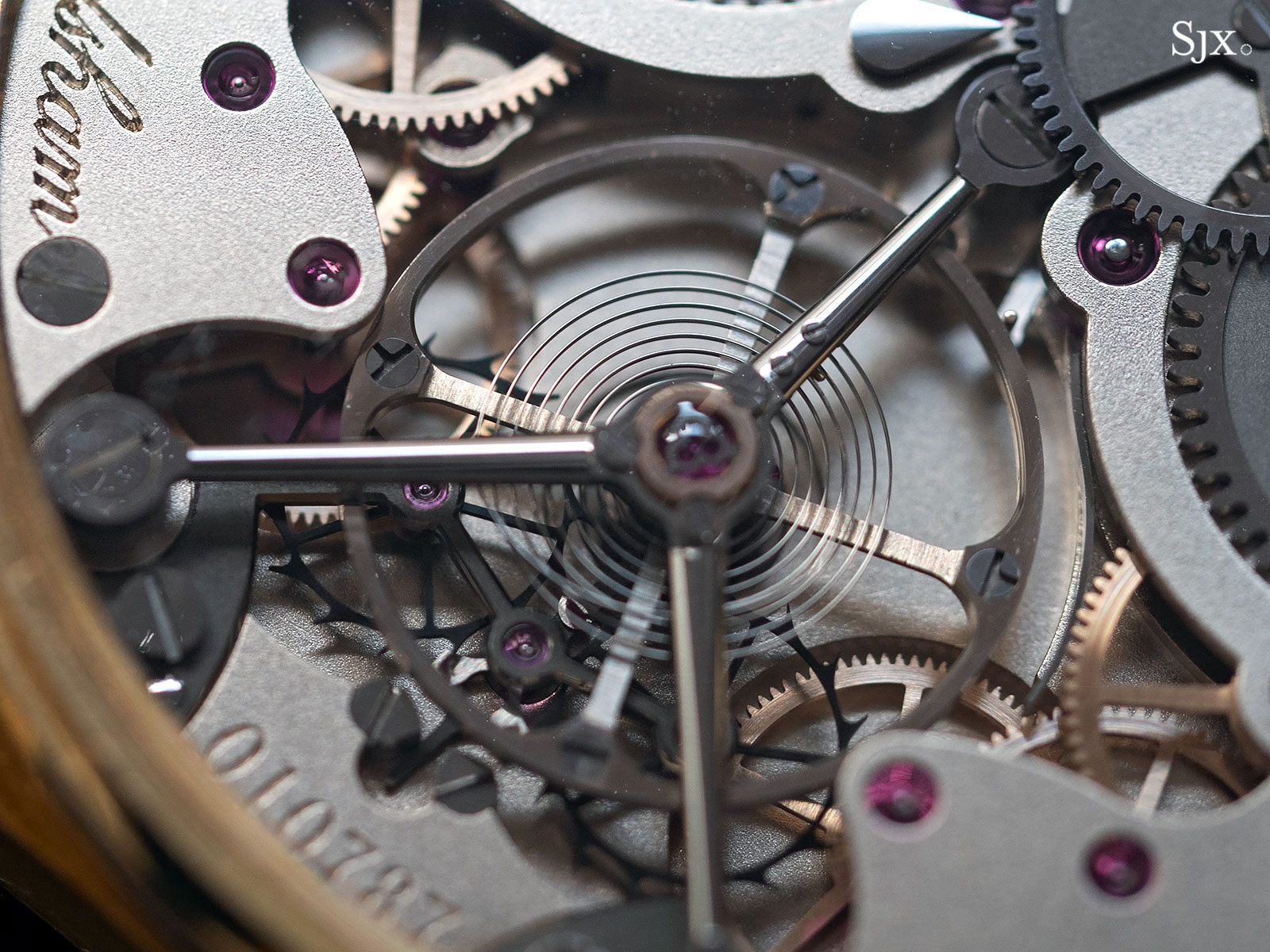
The finishing of the movement is muted, in contrast to the decorative brilliance of modern Swiss watchmaking, which heavily relies on 20th century styles, or a full century after Frodsham. The visual simplicity, however, belies the thought that went into its conception and the effort in execution.
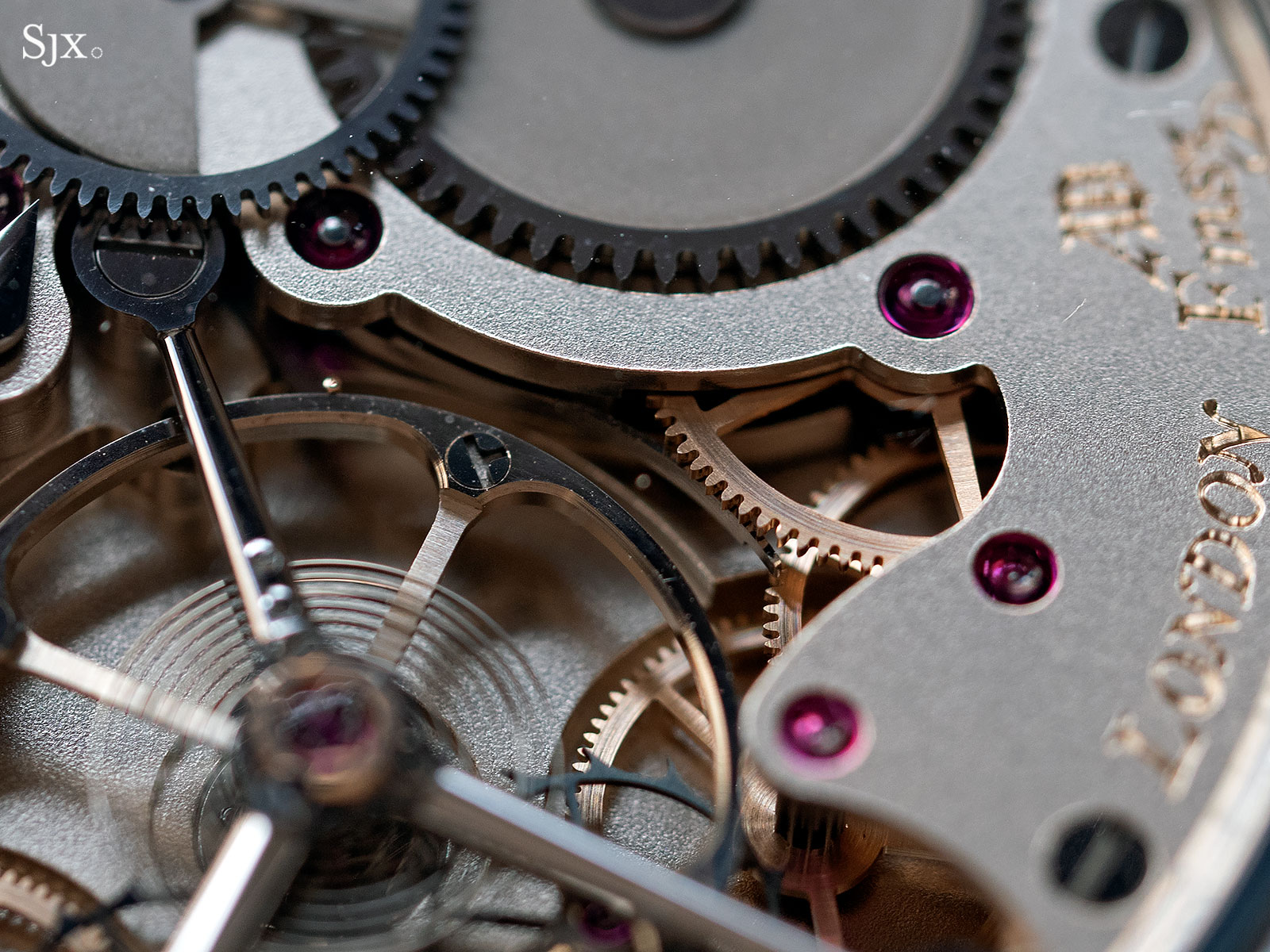
Rounded and polished on all three of its arms, the balance bridge is high carbon steel and the most obvious element of hand finishing in the movement. But equally impressive is the bridge for the twin escape wheels that is finished with a frosted surface and pronounced, polished bevels.
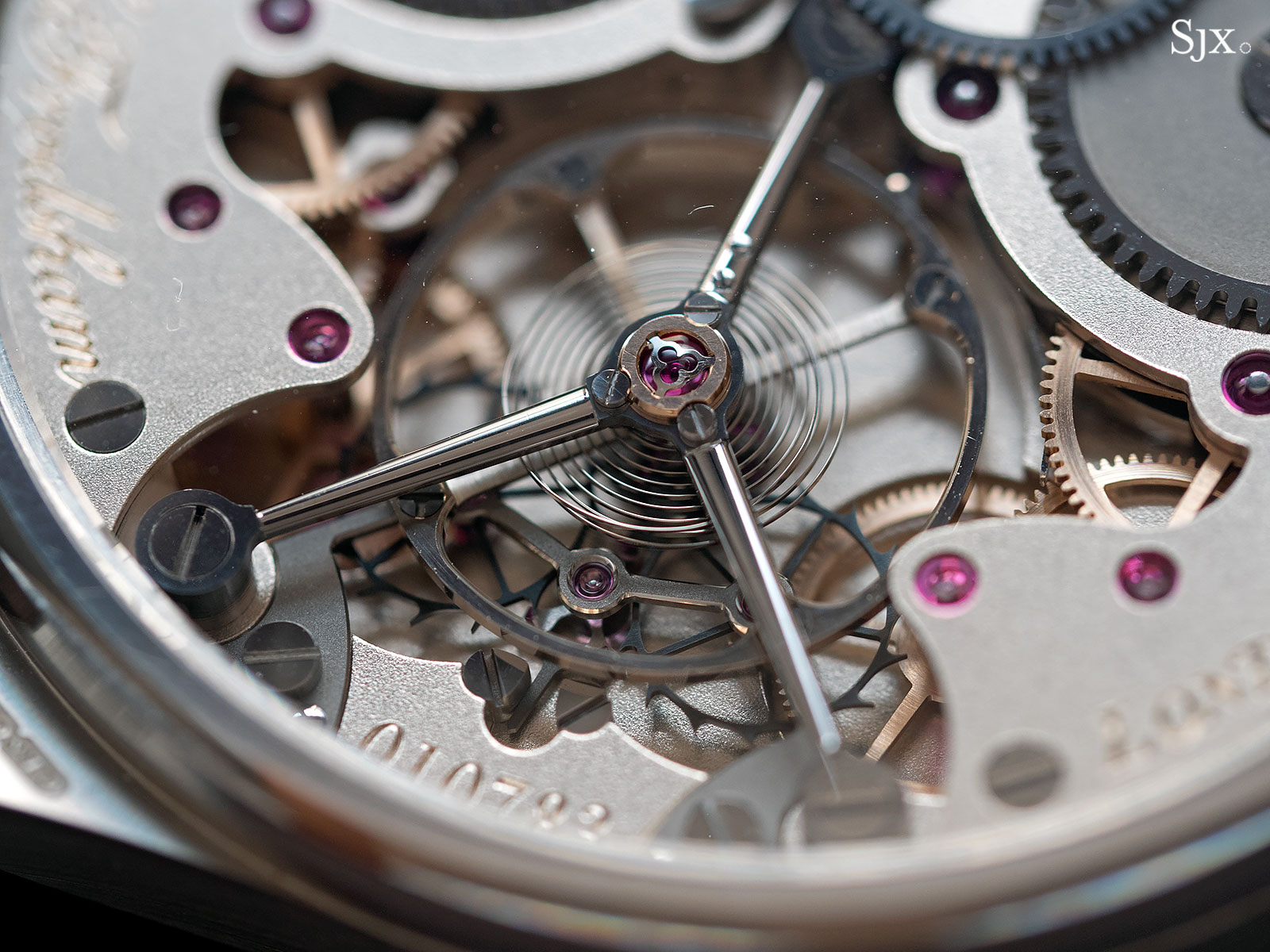
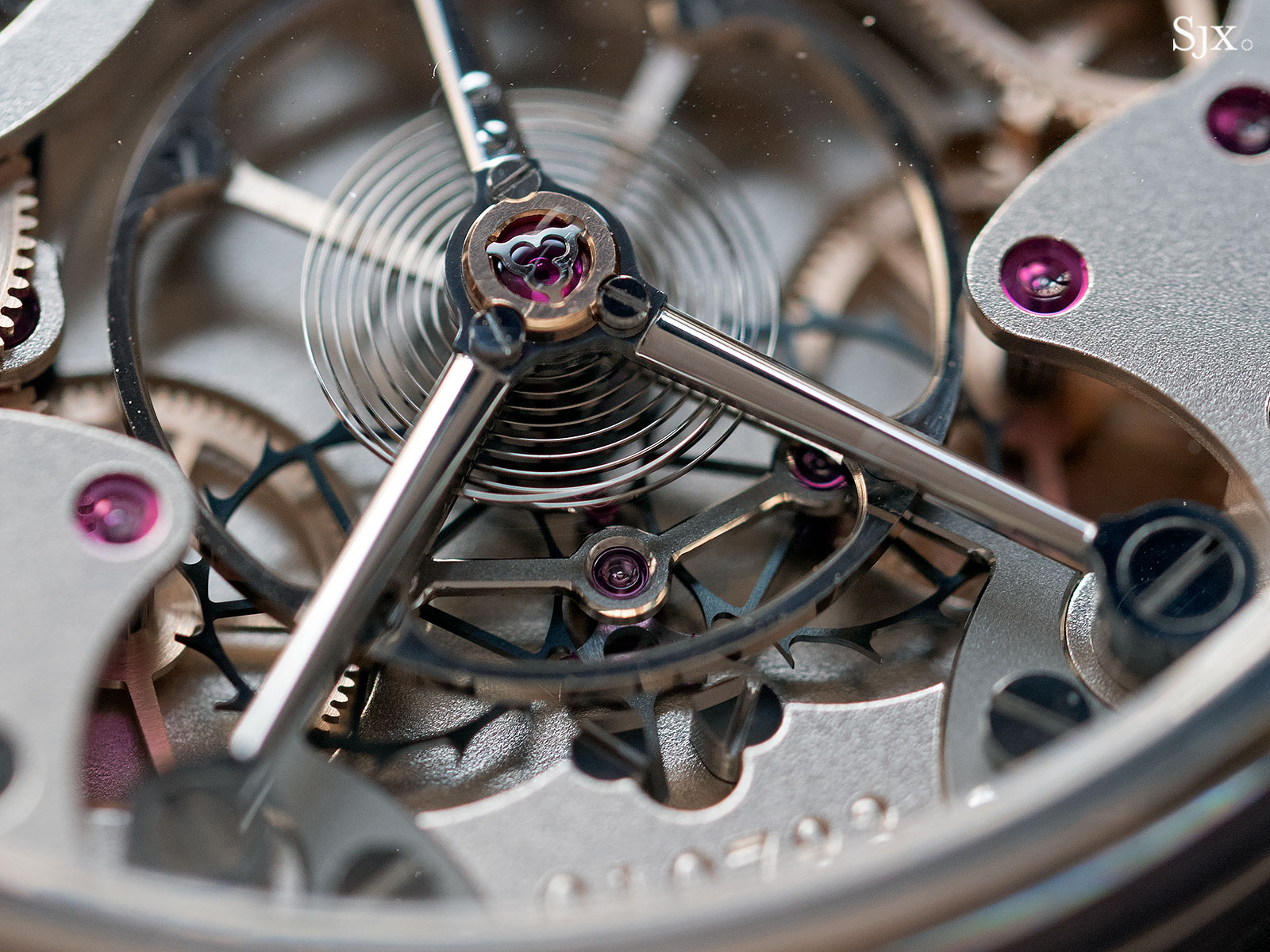
An unusual grey in colour that’s not instantly recognisable, the bridges are made of what Mr Whyte describes as a “one of the strongest copper alloys available… [being] corrosion resistant and has optimised bearing properties, especially in combination with hardened carbon steel components, which translates into increased longevity of the movement. It is significantly harder than German silver which was often used on watch plates.”
The bridges and base plates are finished with a “wet process” of frosted, where metal spheres are blasted with water and compressed air against the plates. According to Mr Whyte, this process was selected for its consistency of result after much trial and error. “We experimented with chemical matting, dry matting, revolving matting brushes”, says Mr Whyte, “We found, certainly from our own research and experience, that ‘dry procedures’ can sometimes stress the metal.”
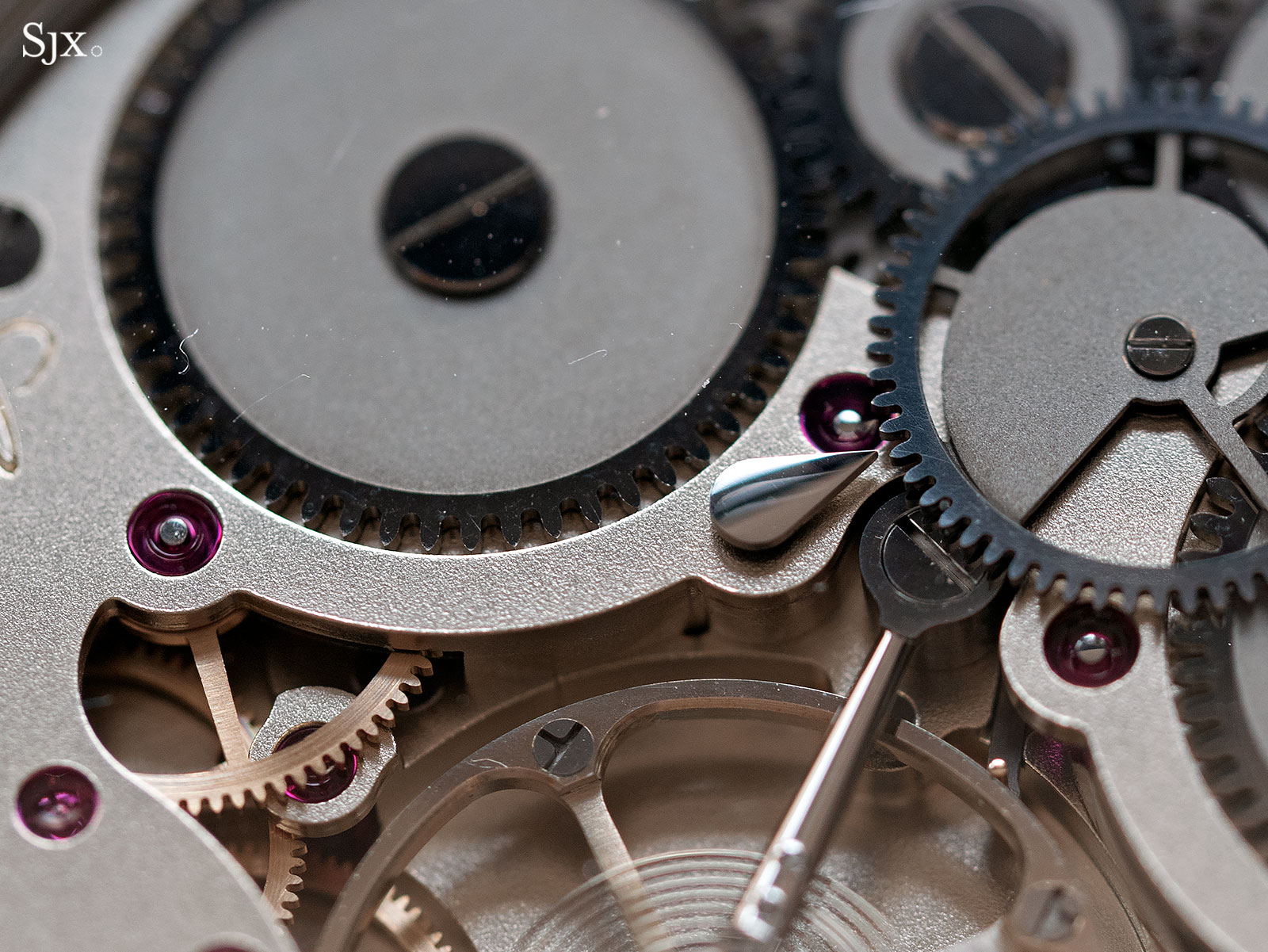
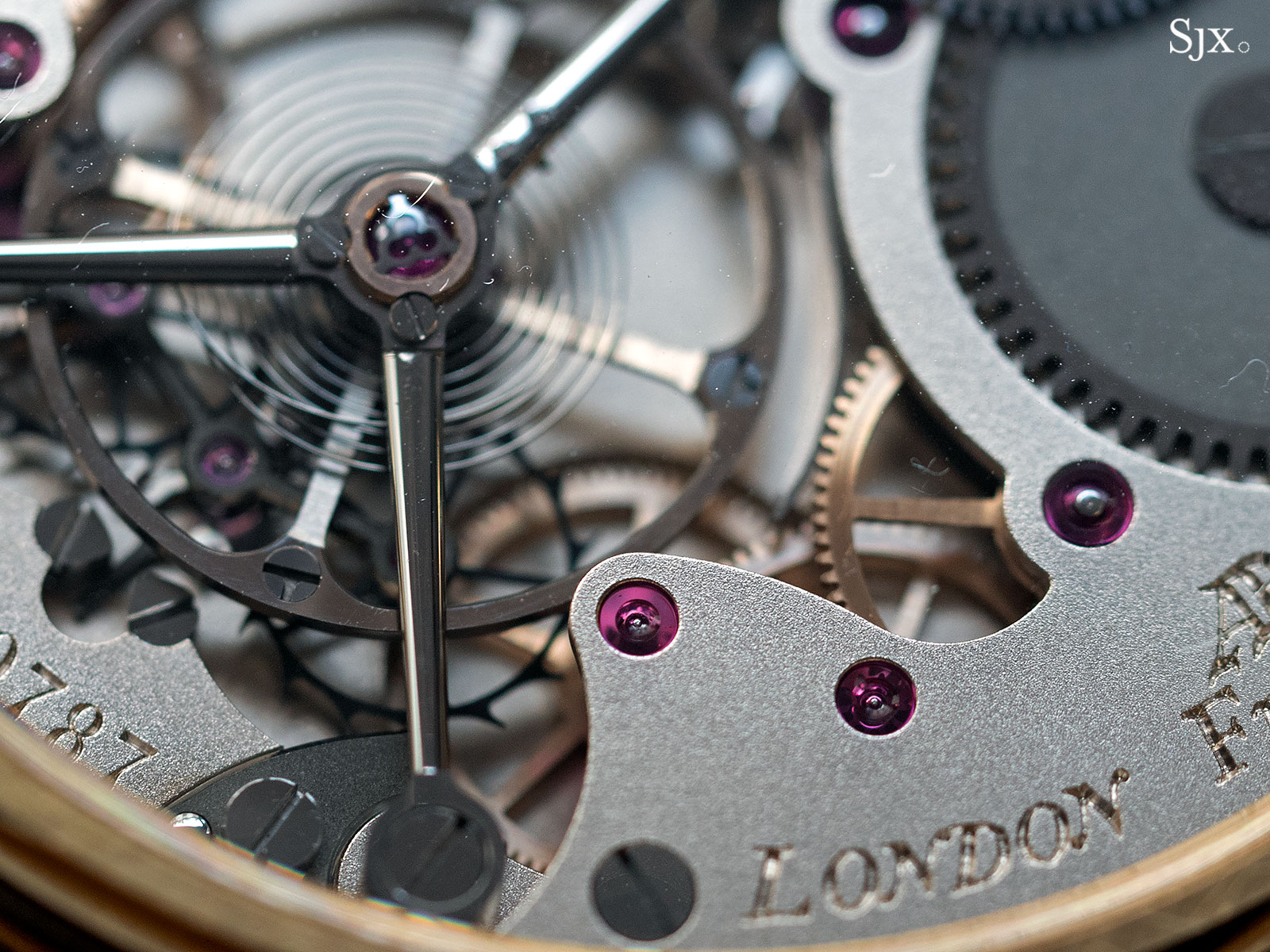
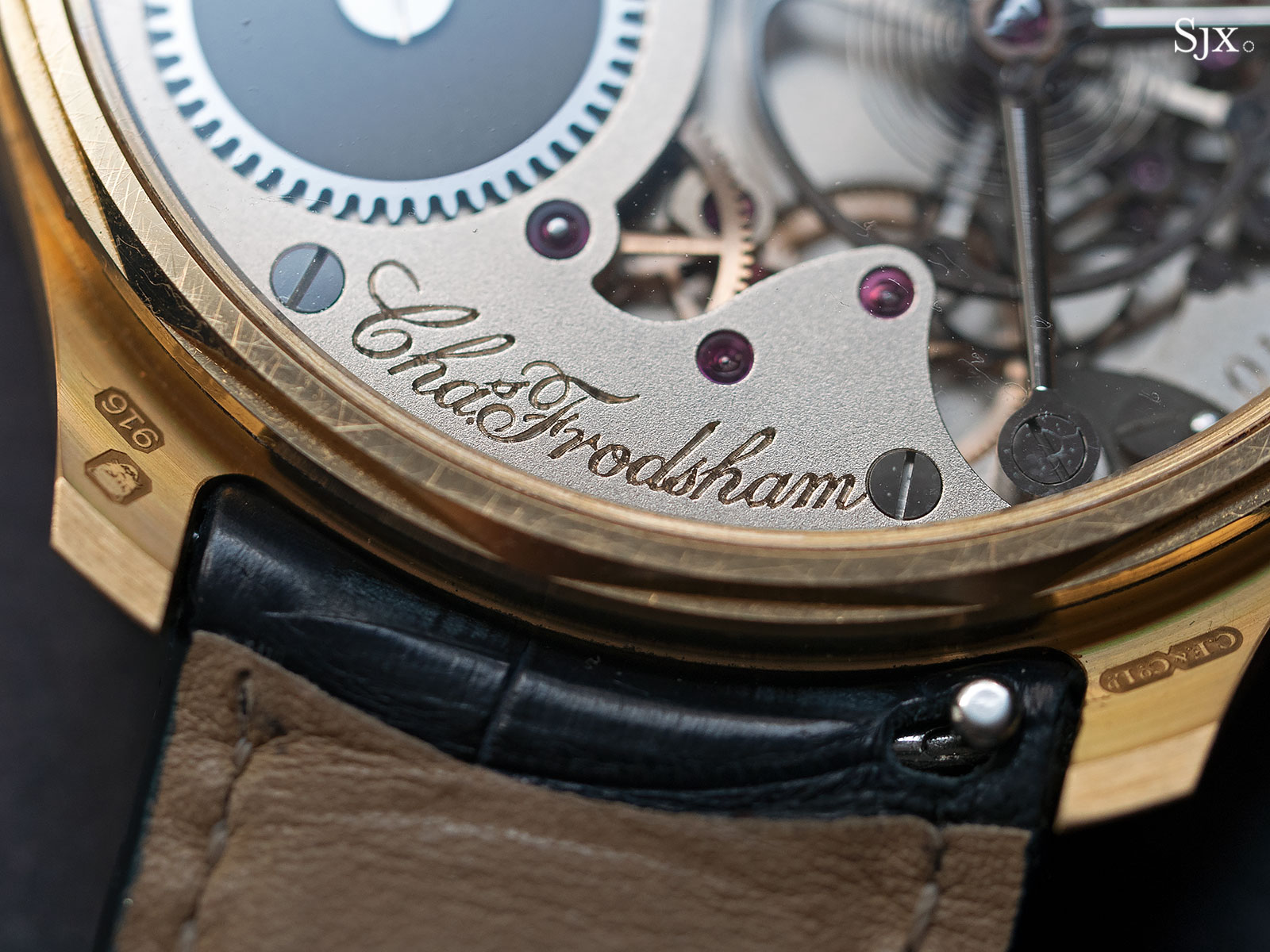
All of the wheels of the going train are made of hardened 18k rose gold, but the winding wheels are all high carbon steel.
The steel winding wheels are finished with a combination of graining and frosting – matte in the centre and black polished on the outer rim – that’s based on early Frodsham pocket watches from the 19th century that had exposed wheels with two forms of finishing. “This dual approach to the finishing had the advantage of visually relieving what could be masses of flat polished winding wheels,” explains Mr Whyte.
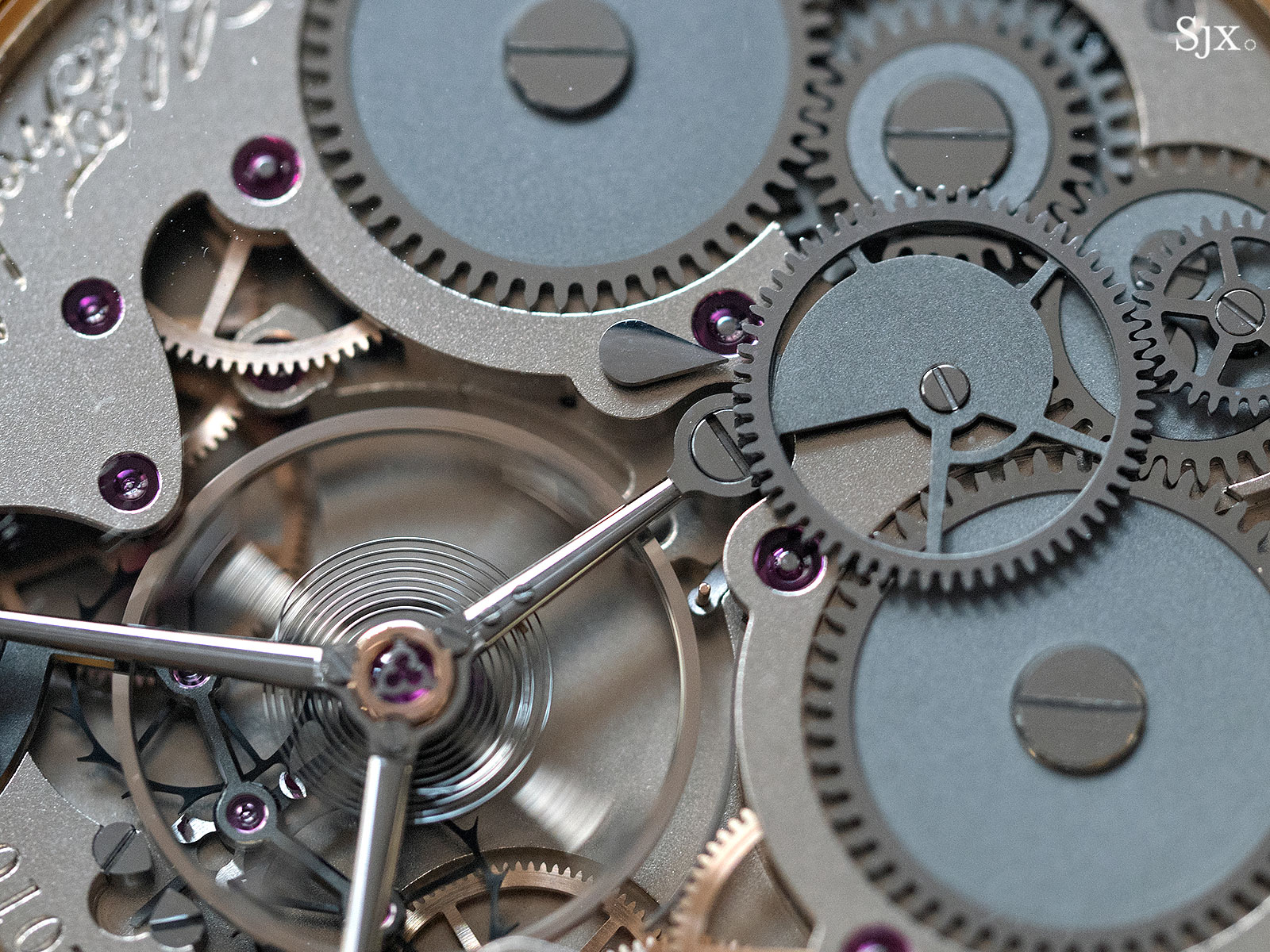
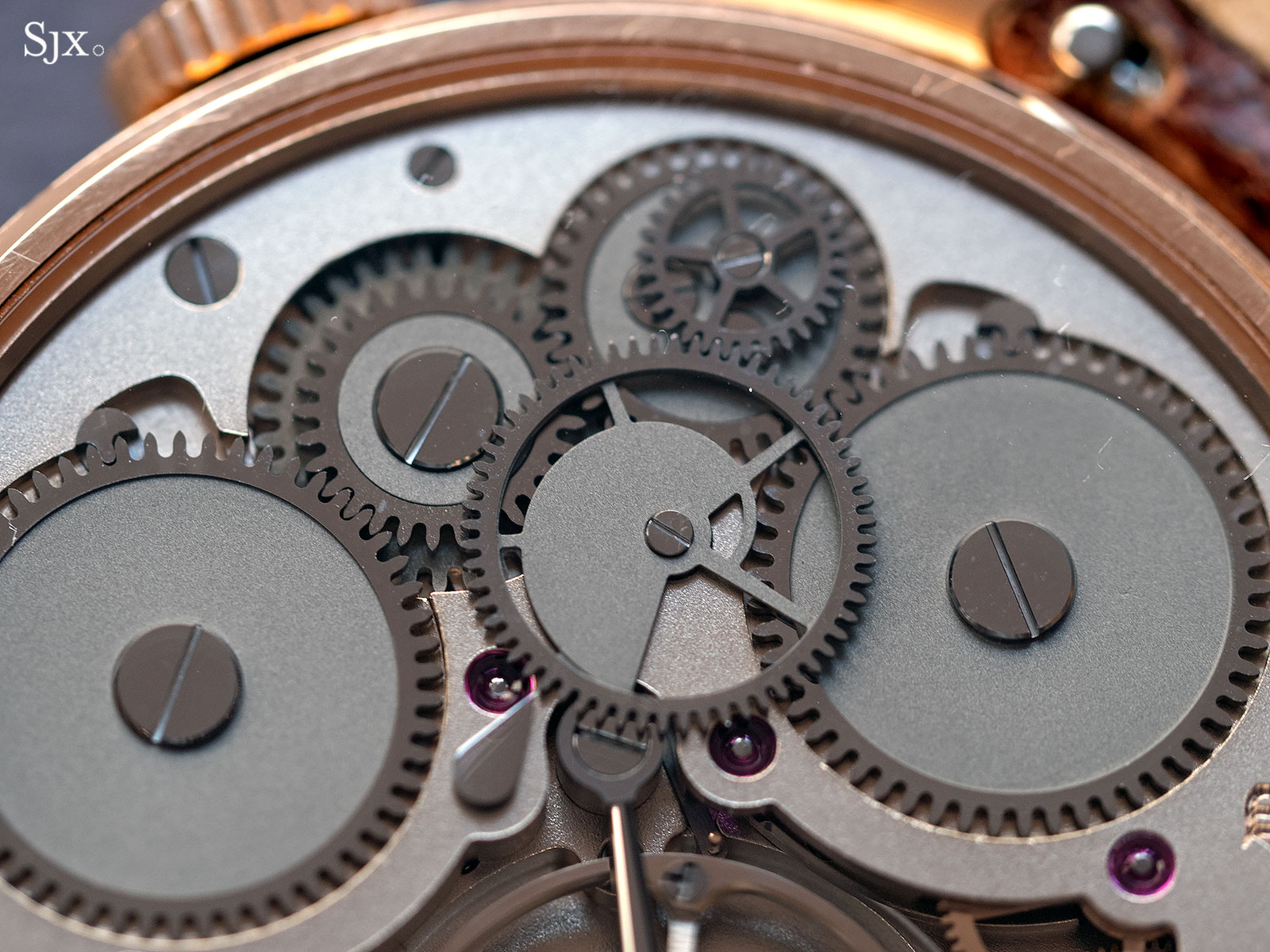
The Frodsham wristwatch starts at the equivalent of US$88,500 in stainless steel. The retail price for all versions was raised several months after the launch because the first three year’s worth of production sold out that quickly, so the new retail prices had reflect what they would cost three years from now.
According to Mr Whyte, “Raw materials costs, component costs, rental costs and of course employee costs will all increase in future years”, and Frodsham had to “take these anticipated cost increases into consideration when pricing a watch for future production and delivery.”
It’s a lot of money for a time-only wristwatch, but relative to the competition it is not inordinately expensive given the tremendous and careful effort that goes into each watch. Despite its simplicity and heavy historical inspiration, the Frodsham wristwatch is arguably high-tech in some of its materials and techniques, which gives it a diverse character that most comparable watches do not have.
Frodsham’s owners will only reveal there are other Frodsham wristwatches in the works, but no more than that. They do, however, leave open the vague possibility of a Frodsham watch that is slightly less elaborate, and consequently more affordable.
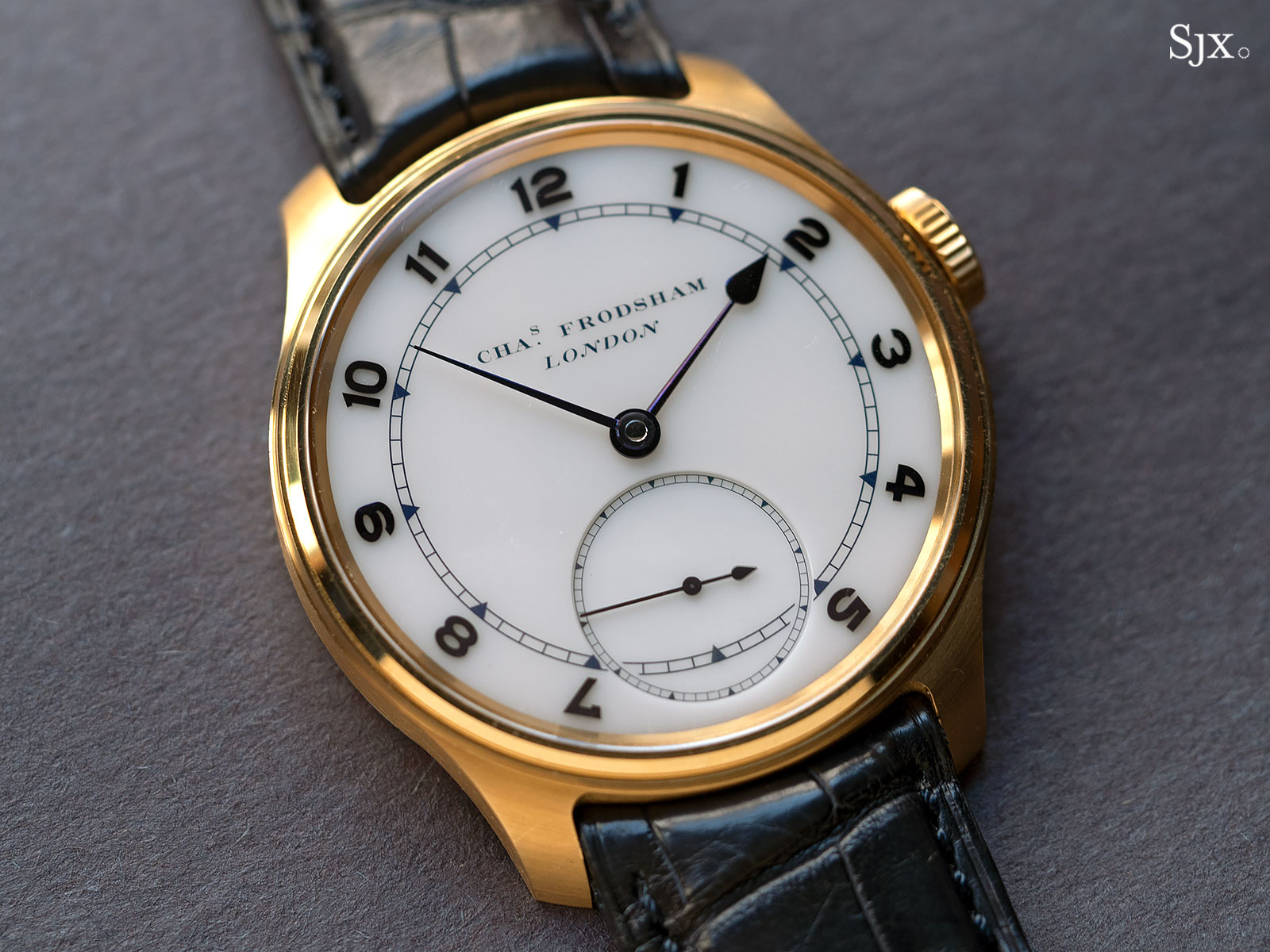
Price and availability
The current wait for the Double Impulse Chronometer Wristwatch is approximately two years, with earliest delivery in 2020. The watch costs £68,500 in steel, £73,000 in 18k rose gold, and £74,500 in 22k yellow gold. Prices exclude taxes. It’s available direct from Charles Frodsham.
Corrections September 10, 2018: Amended the text to indicate the bezels are polished, not brushed, and the dial discs are in fact lapped. And also to clarify the price increase came several months after the launch due to a three-year waitlist, not two.
Back to top.